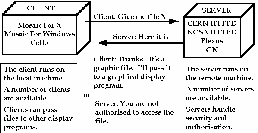
Figure 2-1 WWW Client-Server Architecture.
Distributed: information on WWW may be located on computer systems around the world.
Multimedia: the information held on WWW can include text, graphics, sound and even video.
Hypertext: access to the information is available using hypertext techniques, which typically involve using a mouse to select highlighted phrases or images. Once a phrase or image is selected it can result in information being retrieved from around the world.
The World-Wide Web was initially developed by Tim Berners-Lee and Robert Cailliau of CERN Laboratories, Geneva to provide an infrastructure for particle physicists throughout Europe to share information. Since the physicists were located in various organisations and used a variety of computer systems and applications software (including various word processing and text markup programs for producing reports) the World-Wide Web was developed using the client-server architecture, which ensured cross-platform portability.

Figure 2-1 WWW Client-Server Architecture.
The end user accesses the World-Wide Web using a browser client, typically on a desktop machine such as a PC, Macintosh or Unix workstation. The client will display hypertext links in some manner, such as underlining the links. Selecting a link (by clicking a mouse button with a graphical client, typing the number following the link using a simple text-based client or using speech or foot pedals, for example, with browsers for disabled users) to send a request over the network (which could be a local network, a national network such as JANET, or over the global network which can be referred to as the Internet). The request is sent to a World-Wide Web server, which typically runs on a powerful computer system. The server will retrieve the file which has been requested and deliver it to the client.
Once the client has started to retrieve the file it can display it on the local machine. If the client cannot display the file (many clients, for example, cannot view video clips) the client can pass the file on to an external viewer which can process the file.
This is a very simple overview of the WWW client-server architecture. Many other features are available: for example the server could send a message to the client, saying that the user is not authorised to access the file. However an understanding of this model will help you to see how the WWW can develop.
telnet telnet.w3.org from a computer system which runs the telnet software. An example of use of the CERN command line browser is illustrated below.
telnet telnet.w3.org
Welcome to the World-Wide Web
THE WORLD-WIDE WEB
This is just one of many access points to the web, the universe of
information available over networks. To follow references, just type the
number then hit the return (enter) key.
The features you have by connecting to this telnet server are very
primitive compared to the features you have when you run a W3 "client"
program on your own computer. If you possibly can, please pick up a client
for your platform to reduce the load on this service and experience the
web in its full splendor.
For more information, select by number:
A list of available W3 client programs[1]
Everything about the W3 project[2]
Places to start exploring[3]
The First International WWW Conference[4]
This telnet service is provided by the WWW team at the European Particle
Physics Laboratory known as CERN[5]
[End]
1-5, Up, Quit, or Help:
Figure 2-2 The CERN Command Line Browser.Notice that in the CERN command line browser in order to select a hypertext link you need to type the number which follows the link.
The CERN command line browser is a very simple client. The first WWW browser was developed by Tim Berners-Lee, the father of the World-Wide Web, for the NeXT system. However the NeXT hardware was not a commercial success and is no longer manufactured. One of the earliest graphical browsers was the Viola client which was developed for the X windows environment. Viola is illustrated in Figure 2-3.
Notice that in the Viola client the hypertext links are identified by the use of underlining.
Since CERN's remit was research in particle physics the WWW development
team realised that they needed to involve other organisations in WWW
development work. The involvement of NCSA in the WWW development programme
resulted in the NCSA Mosaic For X, which was released in early 1993. An
illustration of a pre-release version of Mosaic For X is shown in Figure 2-5.
As can be seen from Figure 2-5 NCSA Mosaic For X provides access to a
number of types of resources, including WAIS, Gopher, FTP, Usenet, Hytelnet,
TeXinfo, X.500 and Whois resources. NCSA Mosaic was developed by a group of
programmers at NCSA led by Marc Andreessen. NCSA Mosaic For X became such a
success because:
Browser: An interactive program which is used to access information held
on the World-Wide Web.
Client: Often used as a synonym for browser. A client is the
software which normally runs on the local desktop machine (such as a PC, Apple
Macintosh or Unix workstation). The client sends requests to the server
software.
Server: Software which is used to deliver information to a
client. Note that this term can also refer to the computer system on
which the server software is running.
URL: Uniform Resource Locator. Can be regarded as the address of a file
on the World-Wide Web. It includes the protocol (rules) for retrieving the
file, the domain (name) of the computer system on which the server software
runs and the file name to be retrieved. For example the URL
http://info.cern.ch/hypertext/WWW/TheProject.html
uses the http protocol to retrieve the file
TheProject.html in the directory /hypertext/WWW from the computer called
info.cern.ch
HTML: Hypertext Markup Language. The native language for documents held
on the World-Wide Web. HTML is an SGML (Standard Generalised Markup Language)
application.
HTTP: Hypertext Transport Protocol. The protocol (set of rules) used to
define the communications between the client and WWW server software.
Note that these terms are, for reasons of clarity, in some cases
over-simplified.
An example of the use of the telnet browser at the Radcliffe Science Library at
Oxford University is illustrated in Figure 3-1.
It should be noted that the organisations running these publicly
available clients do not guarantee to provide the service on a long term basis.
Lynx has been ported to the MS DOS environment. DosLynx, as the implementation
is known, will run on a PC with 512 K of RAM, running MS DOS 3 or later. It
provides access to the World-Wide Web from an entry level PC which has the
appropriate networking capability. DosLynx is illustrated in Figure 3-2.
The DosLynx software is available at the URL
ftp://ftp2.cc.ukans.edu/pub/WWW/DosLynx/
Details of the system requirements for DosLynx are available at the URL
ftp://ftp2.cc.ukans.edu/pub/WWW/DosLynx/readme.htm
A Listserv mailing list
exists at the address DosLynx-Dev@ukanaix.cc.ukans.edu for the distribution of
DosLynx related information, updates and development discussions. To subscribe
send an email request to listserv@ukanaix.cc.ukans.edu to be added to the list.
All new releases will be announced on this list.
Further information about NCSA Mosaic For Windows is available at the URL
http://www.ncsa.uiuc.edu/SDG/Software/WinMosaic/HomePage.html
Further
information about NCSA Mosaic For the Macintosh is available at the URL
http://www.ncsa.uiuc.edu/SDG/Software/XMosaic/
Another list, which includes a brief summary of known bugs. is available at the
URL http://www.hotwired.com/browsers.html
A third list is available at the URL
http://www.charm.net/~web/Vlib/Users/Clients.html
Perhaps the only conclusion to be made at this point is that academic
institutions should avoid being locked in to a particular browser.
A simple HTML document is illustrated in Figure 4-1.
Structural elements in the document are identified by start and end
tags. For example the <TITLE> and </TITLE> tag is used to specify
the title of the document, which is often displayed by a client. The
<H1> and </H1> tag is used to define the first level heading.
Clients will normally display headers differently from the body text: for
example, a graphical client could display the header using a larger or
different font, whereas a text-based client could display a header as centred
text or in all capitals.
Figure 4-1 also illustrates the <EM> container. Text held in the
container (which is defined by the <EM> start tag and the </EM> end
tag) will be emphasised in some way. A graphical browser could render the
emphased text by displaying it in italics, whereas a browser with audio
capabilities for the visually impaired could render the emphasis by a change in
the tone of the voice output.
Figure 4-1 also shows the paragraph container. It is important to understand
that the <P> tag is part of a paragraph container and is no longer
a paragraph separator (as many people mistakenly believe). If the </P>
is not used the existence of the next <P> tag will imply a </P>.
In future versions of HTML it will be possible to specify paragraph attributes:
for example <P ALIGN=Centred>.
Although browsers will display the HTML document shown in Figure 4-1, for
reasons of performance and upwards compatibility it is strongly recommended
that HTML documents contain additional elements including the <HTML>,
<HEAD> and <BODY> tags, as shown in Figure 4-2.
The <HTML> container is used to define the extent of the HTML
document. Within the HTML document there are two other containers:
<HEAD> and <BODY>. The <HEAD> container provides information
about the document itself. This can include the title of the document (as
illustrated) copyright information, keywords and expiry dates (for use by
caching software).
It is important to make use of the
Figure 4-2 also illustrates the use of the anchor <A> container. This
tag is used to provide hypertext links. In the example the text at CERN
which is contained between the <A> and </A> tags will be
highlighted in some way by the browser. Selecting this highlighted phrase will
cause the client to send a request for
http://info.cern.ch/hypertext/WWW/TheProject.html
This request will use the
http protocol and will be sent to the server running on the system at
info.cern.ch
Word processing tools have the advantage that they provide a consistent
environment for existing users of word processors. However they do have their
disadvantages. Because they are normally implemented as macros, they can be
very slow, especially when used with large or complicated documents. There is
also a danger that HTML markup which is embedded as hidden text could cause
conflicts with other word processing tools if, for example, the word processed
document was used by other users.
LaTeX2html is available at the URL
ftp://src.doc.ic.ac.uk/packages/WWW/tools/translators/latex2html
Further
information is available at the URL
http://cbl.leeds.ac.uk/nikos/doc/www94/www94.html
RTFtohtml is available as a command line tool for a number of Unix platforms.
In addition an Apple Macintosh implementation is available. A beta version of
an MSDOS implementation was announced in November 1994.
An extension of the RTFtohtml program is known as RTFtoweb. This provides a
number of additional features, including creation of hypertext links at user
defined section breaks. Figure 4-11 illustrates a document on Exploring The
World-Wide Web Using Mosaic For Windows which is available at the URL
http://www.leeds.ac.uk/ucs/docs/tut50/tut50.html
In Figure 4-11 it should be noted that the document is automatically
split into a number of files. A hypertext table of contents is automatically
generated. Chevrons (>> and <<) are also generated automatically
which can be used to move to the next or previous section.
Further information about RTFtohtml is available at the URL
ftp://ftp.cray.com/src/WWWstuff/RTF/rtftohtml_overview.html
The software is available at the URL
ftp://ftp.cray.com/src/WWWstuff/RTF/latest/
In the UK it is available at the URL
ftp://src.doc.ic.ac.uk/packages/WWW/tools/translators/rtftohtml
RTFtoweb is available at the URL
ftp://ftp.rrzn.uni-hannover.de/pub/unix-local/misc/rtftoweb/html/rtftoweb.html
A number of HTML validation tools are available which can validate HTML
documents. A number of popular tools are described below.
HoTMetaL is available for the X and Microsoft Windows
platforms. Two versions of the software are available: a public domain version
and a licensed version. HoTMetaL Pro, the licensed version, can be used to
import and validate an existing document. The public domain version will give
an error and refuse to load a document which contains invalid HTML.
HoTMetaL is available at the URL
ftp://src.doc.ic.ac.uk/packages/WWW/Mosaic/html/hotmetal
A variation on this service is available at the URL
http://www.cc.gatech.edu/grads/j/Kipp.Jones/HaLidation/validation-form.html
These services make of the sgmls validation program.
The software can be installed on your local Unix system. It is available at
the URL
ftp://ftp.hal.com/pub/CGI/check-html.tar.Z
Support Who wrote the software - an experienced software developer or a
student as part of a computer project? Will the software continue to be
developed and supported?
Quality Does the software produce valid HTML?
Functionality What facilities does the software provide?
Other Issues If the software is based on a word processing package,
what happens if the word processed document needs to be used by another word
processor?
A review of Microsoft Windows HTML authoring tools is available at the
URL
http://werple.apana.org.au/~gabriel/html-editors/index.html
A list of HTML tools is available at the URL
http://info.cern.ch/hypertext/WWW/Tools/Filters.html
Dan Connolly's HTML Design Notebook is available at the URL
http://www.hal.com/%7Econnolly/html-design.html
The HTML specification is available at the URL
http://www.hal.com/%7Econnolly/html-spec.html
<IMG SRC="portrait.gif">
The full syntax for the <IMG> tag is:
<IMG SRC="source file" ALT="textual description" ALIGN="option">
The SRC attribute is used to specify the URL of the graphical file. At the
time of writing graphical files should normally be in GIF format, although
support for other graphical file formats may be available in certain browsers.
The SRC attribute is mandatory.
The ALT attribute is used to specify text which should be displayed by a
browser which cannot display graphics, or a browser which has the display of
inline images option switched off. Use of the ALT attribute is highly
recommended.
The ALIGN attribute can take the values TOP, MIDDLE or BOTTOM. It is used to
define whether the top, middle or bottom of the graphic should be aligned with
the text. Use of the ALIGN attribute is optional.
One common use of the <A> tag is to provide a link to a large colour
graphic from a small thumbnail image. For example:
<A HREF="full-image.jpeg"><IMG SRC="thumbnail.gif" ALT="Portrait of
John Smith"></A>
It is also possible to use this technique to provide links from thumbnail
images to video clips. For example:
<A HREF="fluidflow.mpeg"><IMG SRC="fluidflow.thumb.gif" ALT="Video
clip of fluid flow"></A>
An active map can be specified as shown in the HTML document below.
Please select an area of the xray showing cancerous growths.
The file xray.config will contain the coordinates of regions in the image, as
illustrated below.
default error.html
When the user clicks on an area of the image the coordinates are sent to the
cgi-bin/htimage CGI program. The name of the configuration file for the image
(in this case (xray.config) is also sent to this program. The htimage program
will then retrieve the HTML document specified in the confuguration file. If,
for example, the user has clicked in a circle defined by the centre at position
50,50 with a radius of 25, the file homepage.html will be sent to the browser.
If the user has clicked in a rectangle with vertices at the position 100,100
and 500,500 the file cancer.html will be sent to the browser.
The image being manipulated by Paintshop Pro contains information for
256 colour (as shown in the bottom left of the screen). The colour depth of
the image should be reduced to decrease the size of the file to an
appropriate level (e.g. a line drawing should not contain 256 colours), and
thus reduce the network traffic when the image is retrieved on WWW.
San Diego Supercomputer Center's imtools package converts many file
formats, including GIFs.
ImageMagick is a multi-purpose raster converter and manipulation
package. The convert program handles many file formats including GIF. The
software is available at the URL
ftp://ftp.x.org/contrib
Graphics Workshop from Alchemy Mindworks is a DOS package for converting
graphical files.
Before making use of graphics you should consider the following points:
http://www.leeds.ac.uk/ucs/people/BKelly/uniras94/uk_logos.html
This page contains pointers to logos on institutional UK university WWW
servers. Details of the numbers of colours and the file size are also
provideed.
A good example of use of graphics is the Xerox Parc Map viewer which is
available at the URL
http://pubweb.parc.xerox.com/map
A collection of WWW search engines is available at the URL
http://cui.unige.ch/meta-index.html
Some of the main searching tools are
listed below:
There are a number of problems with this approach to global indexing:
A list of robots is kept at the URL
http://web.nexor.co.uk/mak/doc/robots/active.html
Further information about Aliweb is available at the URL
http://web.nexor.co.uk/aliweb/doc/aliweb.html
The paper ALIWEB -
Archie-Like Indexing In the Web, which was presented at the WWW 94
conference in CERN, is available at the URL
http://web.nexor.co.uk/mak/doc/aliweb-paper/paper.html
The command:
waisserver -p 210 -d /apps/info/WWW/WAIS
is used to start the WAIS server software. The -p 210 argument
specifies the name of the port on which the server runs while the -d argument
gives the name of the directory which will contain WAIS databases. Note that
since the WAIS server will normally be running continuously it will normally be
initiated by the system administrator.
Newsletters are indexed by giving the command
waisindex -export -d
/apps/info/WWW/ucs/newsletter/wais-sources/computing-service-newsletter -T HTML
*.html
The name of the WAIS database is computing-service-newsletter This long
name is used since a single directory is used for all WAIS databases - it will
save confusion if other departments wish to index their own departmental
newsletters.
The WAIS database can be accessed by a dedicated WAIS client or by a WWW
browser which contains support for the WAIS protocol. The WAIS database can be
accessed by giving the URL
wais://www.leeds.ac.uk/computing-service-newsletter
wais.pl is a CGI script which is distributed with the NCSA httpd
server.
Son of wais.pl is a CGI script which is based on the wais.pl script.
SFGate is a CGI script which interfaces to WAIS servers. SFGate
provides a forms interface which can be used to access a number of WAIS
databases. It is available at the URL
http://ls6-www.informatik.uni-dortmund.de/SFgate/SFgate.html
A demonstration
is available at the URL
http://ls6-www.informatik.uni-dortmund.de/SFgate/multiple.html
wwwwais is a small ANSI C program that acts as gateway between waisq or
waissearch (programs that search WAIS indexes) and a forms-capable World-Wide
Web browser. With the freely distributable freeWAIS package, this program, and
your local Web site, you can:
You can FTP the source and related files from the URL
ftp://ftp.eit.com/pub/web.software/wwwwais/
You can see how it looks at the URL
http //www.eit.com/cgi-bin/wwwwais
A directory is created for each multimedia object. The directory contains the
multimedia object itself (e.g. a graphical file, video clip or sound file)
together with a keyword file which describes the object. The keyword files are
indexed using WAIS. A WWW browser which supports forms is used to run a CGI
script. The CGI script invokes the waisq command to search the WAIS
database. The output from waisq is then used to create a HTML file which
contains a pointer to a thumbnail image of matching multimedia objects.
freeWAIS-sf is an implementation of WAIS developed at Dortmund
University. It is available at the URL
ftp://ls6-www.informatik.uni-dortmund.de/pub/wais/freeWAIS-0.2-sf-beta.tar.gz
A mailing list has been established to discuss Isite. To join, send an -mail
message to listserv@vinca.cnidr.org with the body of the message as
subscribe ISITE-L your name To post messages to the list, send
to isite-l@vinca.cnidr.org.
Further information is available at the URL
http://vinca.cnidr.org/software/Isite/Isite.html
A WAIS overview is available at the URL
http://info.cern.ch/hypertext/Products/wais/sources/Overview.html
A list of resources about the Z39.50 information discovery protocol is
available at the URL
http://ds.internic.net/z3950/z3950.html
This section gives an example of how to install and run a server for the
Microsoft Windows environment. The section then goes on to illustrate a number
of server management issues which are based on the CERN server for the Unix
platform.
Connect to the NCSA server software from the anonymous FTP server at
ftp.ncsa.uiuc.edu Then change directory to
/Web/httpd/Uni/ncsa_httpd/contrib/winhttpd Finally retrieve the file
whtp13p1.zip An example of how to do this using the FTP software is
illustrated below.
ftp src.doc.ic.ac.uk
PKZUNIP -D WHTPP13P1.ZIP
The -D option will preserve the directory structure from the compressed file.
Run Microsoft Windows and create a program icon using the New option on the
File menu. The icon should point to the file C:\HTTPD\HTTPD.EXE
Set the time zone in the AUTOEXEC.BAT file so that TZ=GMT.
Run the server program. The window shown below should be displayed.
Run a World-Wide Web browser and then enter a URL containing the IP
address of your PC. For example if your PC has an IP address of 192.11.1.1 you
should enter the address:
http://192.11.1.1/
The following diagram illustrates NCSA Mosaic for X accessing a server running
on a PC.
This example is meant to illustrate the installation of a WWW server.
In practice the server software is likely to run on a more robust system than a
PC running MS DOS, such as a Unix or Windows NT system.
map / file:/apps/WWW/homepage.html
Figure 7-3 shows a simple configuration file for the CERN httpd server.
Line 2 specifies that files located under the directory /apps/WWW should be
available to the WWW server software. Line 1 specifies that file
/apps/WWW/homepage.html is the default file to be displayed when the WWW server
is accessed.
protection prot-proxy { # Part 1
Figure 7-4 shows another configuration file (this is for illustrative
purposes - some options may have been superceeded). The various features are
summarised below:
Parts 1 and 2 provides a mechanism for ensuring that the proxy gateway cannot
be accessed from outside the local domain. Without these options it would be
possible for a browser on an external system to use the proxy gateway to gain
access to files which are restricted to local use.
Part 3 passes requests for the httpd, gopher, wais and ftp protocols.
Part 4 specifies the location for CGI files.
Part 5 specifies the area of the filestore which can be accessed by the
server.
Part 6 describes the location and format of the server log file.
Part 7 specifies that server caching is to be available, and gives the location
of the cache and the cache log files, together with the size (in Mbytes) of the
cache.
Part 8 specifies the purging frequency for files in the cache.
An example of a typical httpd.log file is shown below.
abc.cs.xyz.edu - - [21/Nov/1994:21:58:58 +0000] "GET /music.html HTTP/1.0" 200
4375<>
gps0 - - [21/Nov/1994:21:59:48 +0000] "GET / HTTP/1.0" 200 2782
Note that the names of the machines accessing files from the server have
been altered in the diagram. This has been done because it could be argued
that such information should be confidential.
A number of servers also support caching by the server. This is illustrated in
Figure 7-6.
Caching can improve the performance of a WWW service by ensuring that
frequently requested files will tend to be stored in the local cache. There
is, of course, a danger that if the file on the remote server is updated that
an out-of-date file will be retrieved from the cache. In practice, however,
httpd server software which supports caching can deal with this issue by, for
example, looking at the date of the file on the remote server and, if the
remote file is newer than the file in the cache, replacing the file in the
cache with the new version of the file.
[Proxy Information]
http_proxy: www.leeds.ac.uk
It order for a client to make use of a cache on a server, the client
configuration file (e.g. the MOSAIC.INI file) must be suitably configured.
Figure 7-7 illustrates the relevant options for the MOSAIC.INI file.
Accesses of the cache are recorded in the cache log file. A typical log file
is illustrated in Figure 7-8.
xyz_pc77.leeds.ac.uk - - [21/Nov/1994:00:43:35 +0000] "GET
http://white.nosc.mil/gif_images/NM_Sunrise_s.gif HTTP/1.0" 200 18673
Note that the names of the machines accessing files from the cache have
been altered in the diagram. This has been done because it could be argued
that such information should be confidential.
An institution will need to decide whether to use a caching service and, if so,
whether to have caching services running on a number of departmental system, to
have an institutional caching service, or to use the national caching service
at HENSA. In the future it may be possible to chain caches. The possibility
in the long term of having institutional, metropolitan, national and
continental caches should be considered.
In practice there is a technique known as proxy gateways which can be
used to provide access to services off-campus, without compromising local
security. With a proxy gateway a trusted system (typically a Unix system which
is more secure to hacking than a desktop machine) will have Internet access.
Machines in open access cluster can point to the proxy gateway, which will then
retrieve information from off-campus services.
It should be noted that with increasing usage of Internet services such as the
World-Wide Web, the author believes that the provision of security mechanisms,
such as proxy gateways, will be increasingly important.
map /* file:/apps/WWW/*
then clients will only be able to access files held under the directory
/apps/WWW/.
Note This statement refers to clients running on remote machines. If
the client is running on the same machine as the server, the client will
normally be able to access files on the server to which it has read access.
Additional levels of security can also be specified:
Servers have been developed for the Windows NT environment. This may provide a
robust operating system environment which can be used for providing a WWW
server on an Intel platform.
Information about HTTP/NG is available at the URL
http://info.cern.ch/hypertext/WWW/Protocols/HTTP-NG/http-ng-status.html
The HTTP/1.0 specification has been submitted as an Internet-Draft and
is available for comment at the following URLs:
http://www.ics.uci.edu/pub/ietf/http/draft-fielding-http-spec-00.txt
and
ftp://www.ics.uci.edu/pub/ietf/http/draft-fielding-http-spec-00.txt
The document Setting up a World-Wide Web Server, which is available at
the URL
http://scholar.lib.vt.edu/reports/Servers-web.html
, gives advice on
setting up a server.
A collection of utilities intended especially for WWW system
administrators is available at the URL
ftp://src.brunel.ac.uk/WWW/managers/
A list of server software is available at the URL
http://www.cern.ch/hypertext/WWW/Daemon/Overview.html
A list of server software is available at the URL
http://www.charm.net/~web/Vlib/Providers/Servers.html
A list of server software is available at the URL
http://akebono.stanford.edu/yahoo/Computers/World_Wide_Web/HTTP_Servers/
A hypermail archive of the HTTP-WG mailing list is available at the URL
http://www.ics.uci.edu/pub/ietf/http/hypermail/
When a client receives a file from a server it checks on the file type. If the
file type indicates that it is an HTML document, the file will be displayed by
the browser. Otherwise the browser's configuration file can specify an
external viewer which can be used to display the file. A list of widely used
external viewers is given in Table 8-1.
The association between the file type and the viewer is given in the
browser's configuration file. A typical configuration file for Mosaic for
Windows is given in Figure 8-1.
[Viewers]
As a general principle there are dangers in automatically invoking applications
from WWW clients.
Further details on the W3Launch program is available at the URL
http://www.leeds.ac.uk/bionet/student/pre-stud.htm
It should be noted that W3Launch is an application developed at the
Unievsrity of Leeds - it is not part of WWW itself.
#!/bin/sh
The program, which is a C shell script which runs on the Unix server
system, can be executed by selecting the URL
http://www.leeds.ac.uk/ucs/cgi-bin/phone
When the URL is selected since no arguments are provided, the first part of the
if statement is run. This will generate the following HTML document:
<HEAD>
The <ISINDEX> tag generates a search dialogue box. The HTML
document is rendered as shown below.
When text is entered in the Search box and the <Enter> key
pressed, the script in Figure 8.4 is executed again. This time, since the
program will be given an argument, the second part of the if statement will be
executed. This will generate the HTML tags and then invoke the Unix grep
command to search a file for lines containing the search string.
Examples of the use of CGI programs are available at the URl
http://hoohoo.ncsa.uiuc.edu/cgi/examples.html
A tutorial on CGI is available at the URL
http://www.charm.net/~web/Tutorial/CGI/
A CGI Programmer's Reference is available at the URL
http://www.halcyon.com/hedlund/cgi-faq/
An archive of useful CGI programs is available at the URL
ftp://ftp.ncsa.uiuc.edu/Web/httpd/Unix/ncsa_httpd/cgi/
A form is defined by the <FORM ...> and </FORM> HTML tags. The
<FORM> tag has the syntax:
<FORM METHOD="method" ACTION="url">
For example:
<FORM METHOD="post" ACTION="http://leeds.ac.uk/ucs/cgi-bin/myscript">
will send the input data to be processed by myscript.
An example of a form is shown below:
<TITLE>Fill-Out Form Example #7</TITLE>
This example is available at the URL
http://www.ncsa.uiuc.edu/SDG/Software/Mosaic/Docs/fill-out-forms/example-7.html
The way in which form is displayed is illustrated below.
A forms testing suite is available at the URL
http://www.research.digital.com/nsl/formtest/home.html
w3new is a program which will extract a list of URLs from the Mosaic
client hotlist file or extract URLs from a HTML document. It will then
retrieve the modification dates for each document listed and output a HTML file
with the URLs sorted by their last modification date.
Information about the program is available at the URL
http://www.stuff.com/~bcutter/home/programs/w3new/w3new.html
The utility was
written by Brooks Cutter
(mailto:bcutter@stuff.com).
wusage is a WWW server usage meter which produces weekly activity
reports in HTML. In addition it provides graphical displays of server usage.
Further information is available at the URL
http://siva.cshl.org/wusage.html
The software is available from the URL
ftp://isis.cshl.org/pub/wusage
wusage
was written by Thomas Boutell
(mailto:boutell@netcom.com).
getstats (formerly called getsites) is a versatile WWW server log
analyser. It is available at the URL
http://www.eit.com/software/getstats/getstats.html
weblint is a Unix utility for checking the syntax of HTML documents.
The checks include illegally nested, overlapped, unclosed and obsolete tags.
Further details are available at the URL
http://www.khoros.unm.edu/staff/neilb/weblint.html
The software can be
obtained from the URL
ftp://ftp.khoros.unm.edu/pub/perl/www/.
The utility was
written by Neil Bowers, Khoral Research Inc.
(mailto:neilb@khoros.unm.edu) The
email list weblint@khoros.unm.edu provides announcements of new versions of
Weblint. Email Neil Bowers if you wish to be added to the list.
Verify_links is a robot which performs link verification. Further
information is available at the URL
http://wsk.eit.com/wsk/dist/doc/admin/webtest/verify_links.html
MOMspider (Multi-Owner Maintenance spider) is a tool which can be used
to help information providers and system managers to maintain links to
documents. MOMspider is available at the URL
http://www.ics.uci.edu/WebSoft/MOMspider/
Hypermail is a program that converts a file of email messages to a
hypertext WWW form. It is available at the URL
http://gummo.stanford.edu/html/hypermail/hypermail.html
The following utilities are available at the URL
ftp://src.doc.ic.ac.uk/pub/packages/infosystems/WWW/tools
checkweb looks for dead links in your Web
html+tables.shar creates preformatted text tables from HTML+ Table
definitions
mosaic-wais-cli.pl does a WAIS search using Mosaic from the command
line
newslist/ compiles an HTML page of links to all newsgroup on your
server
simon/ URL database to replace NCSA Mosaic's Hotlist
test-cgi/ sets up HTTP environment for a CGI script
url-get.pl a perl script which brings in any document given its URL
w3get.pl retrieves a HTML page named by a URL and all HREFs and IMGs in
it
The author does not know the answer to these questions. Fortunately WWW is
attracting the interests of lawyers, philosophers and artists who are starting
to address these issues. Many of the papers which have been published address
issues which affects WWW providers in the USA. The American Constitution, and
in particular the amendment on free speech, means that much of the work
published in the USA in this area is not relevant to the UK.
A future edition of this handbook may contain information relevant to UK
legislation and culture. This edition covers a number of issues are raised
which WWW service and information providers should consider.
However even the most liberal individual is likely to be offended by some of
the pornography which is believed to be available on the Internet. In addition
UK legislation on computer pornography is likely to be introduced shortly.
This could mean that universities have a legal obligation to concern itself
with computer pornography.
A WWW manager may have the responsibility to ensure that copyright materiel is
not made available unless the copyright holder has granted permission. This
may affect research papers which have been submitted for publication. It may
also affect the use of photographs, drawings and maps, for which the copyright
may be owned, for example, by the photographer or the organisation which
commissioned the photograph.
JANET may be used for any legal activity in furtherance of the aims and
policies of a connected organisation, subject to a number of rules. For
example, the following uses are not permitted on JANET:
Cranfield University have published guidelines for information providers which
is available at the URL
http://www.cranfield.ac.uk/docs/publish_code.html
Information about the Data Protection Act is available at the URL
http://www.open.gov.uk/dpr/dprhome.htm
The HCC CWIS was developed to support its goal of becoming the
"Technological Training Centre of the Pacific". The most important
aspects of developing and managing an effective CWIS are managerial and not
technical. Formulating the objectives of a CWIS, resourcing it and developing
a training programme are key issues which an institutional needs to address.
The Universities and Colleges Teaching, Learning and Information Group (UCTLIG)
are producing a CWIS Manager's Handbook which will address many of these
issues.
Polly-Alida Farrington's listing of CWISes is available at the URL
http://www.rpi.edu/Internet/cwis.html
Lists of (global) CWISes are available at the URLs
http://www.rpi.edu/Internet/cwis.html
and
http://kawika.hcc.hawaii.edu/ws94/cwis.html
The CWIS-L Listserv mailing list provides a forum for the discussion of topics
related to campus-wide information systems. To subscribe send the message
SUB CWIS-L your name to the address LISTSERV@MSU.EDU
A Framework for Administering NASA's Web Information Hypermedia is
available at the URL
http://naic.nasa./gov/www-framework.html
A more sophisticated teaching application was developed by the School of
Chemistry in conjunction with Imperial College. The example illustrated in
Figure 12-2 makes use of a chemistry MIME type.
In this example the WWW client is configured to associate the MIME type
with the RasMol program. For example in NCSA Mosaic For X the line:
chemical/x-pdb; rasmol %s
is included in the .mailcap file. When a URL with the extension .pdb is
selected the file will be downloaded and the Rasmol program launched, as
illustrated in Figure 12-2.
Further information on this project is available at the URL
http://chem.leeds.ac.uk/Project/MIME.html
The Globewide Network Academy (GNA) is a consortium of educational and
research organisations. Its mission is to provide a central organisation in
which students, teachers, scholars and researchers can meet and interact.
Further information about GNA is available at the URL
http://uu-gna.mit.edu:8001/uu-gna/
Mark Cox, Department of Industrial Technology, University of Bradford
presented a paper at the Mosaic and the Web conference on Robotic
Telescopes: An Interactive Exhibit on the Web. This paper is available at
the URL
http://www.eia.brad.ac.uk/mark/wwwf94/wwwf94.html
Mark also has a collection of pointers to hardware control services over the
Web which is available at the URL
http://www.eia.brad.ac.uk/mark/fave-inter.html
A Virtual Frog Dissection Kit has been developed at the LBL. It is
available at the URL
http://george.lbl.gov/ITG.hm.pg.docs/Whole.Frog/Whole.Frog.html
CTISS is available at the URL
http://www.ox.ac.uk/cti/
CTI Centre For Biology is available at the URL
http://www.liv.ac.uk/ctibiol.html
CTI Centre For Chemistry is available at the URL
http://www.liv.ac.uk/ctichem.html
CTI Centre For Law is available at the URL
http://crocus.csv.warwick.ac.uk/WWW/law/default.html
CTI Centre For Psychology is available at the URL
http://ctipsych.york.ac.uk/
CTI Centre For Sociology is available at the URL
http://lorne.stir.ac.uk/departments/cti_centre/
CTI Centre For Textual Studies is available at the URL
http://www.ox.ac.uk/depts/humanities/
BioNet Project is available at the URL
http://www.leeds.ac.uk/bionet.html
CLIVE Project is available at the URL
http://www.vet.ed.ac.uk/
Insurrect Project is available at the URL
http://av.avc.ucl.ac.uk/
Institute Of Computer Based Learning, Heriot-Watt is available at the
URL http://www.icbl.hw.ac.uk/
INTERACT Project is available at the URL
http://medusa.eng.cam.ac.uk/~interact/
Interactive Learning Centre, University of Southampton is available at
the URL http://ilc.ecs.soton.ac.uk/welcome.html
ITTI is available at the URL
http://www.hull.ac.uk/Hull/ITTI/homepage.html
PsyCLE Project is available at the URL
http://ctipsych.york.ac.uk/Psycle/PsyCLEinfo.html
STILE Project is available at the URL
http://indigo.stile.le.ac.uk/
TLTP is available at the URL
http://www.hcbl.hw.ac.uk/tltp/
TLTP Archaeology Consorteum is available at the URL
http://www.brad.ac.uk/acad/archsci/homepage.html
TLTP Mathematical Project is available at the URL
http://othello.ma.ic.ac.uk/
Pointers to global uses of WWW for teaching is available at the URL
http://wwwhost.cc.utexas.edu/world/instruction/index.html
Harry Kriz's paper "Teaching and Publishing in the World Wide Web" is
available at the URL
http://learning.lib.vt.edu/webserv/webserv.html
One interesting application of a multimedia desktop conferencing systems
is MONET (Meeting on the Network) which is described in Applications of
Mosaic in Health Care Delivery by Srivasa et al. This paper, which
was presented at the Mosaic and The Web conference, is available at the
URL
http://www.ncsa.uiuc.edu/SDG/IT94/Proceedings/MedTrack/srivasa/artemis.html
At the time of writing many of these services are experimental.
However, given the rapid growth of WWW and the extent of development work which
is going on, such services may be mainstream in the near future.
About 200 of the papers which were given at the second WWW conference,
Mosaic and The Web, were available on WWW before the conference began.
Perhaps one important question which the academic community should be
addressing is whether it should be the standard practice for conference
proceedings to be made available on WWW.
Examples of conference proceedings available on WWW is given in Appendix 5.
In Figure 14-1 a form is completed. The term Internet is used as a
search term. Once the form is submitted the data is sent to a CGI program. In
this case the CGI program is a C program which invokes the BRS free text
retrieval system. The output from the BRS program is then processed to
generate the appropriate HTML markup. The output from the search is
illustrated in Figure 14-2.
SALSER is an online information service about serials held in Scottish
academic and research libraries. It can be accessed at the URL
http://salser.ed.ac.uk/
The Clearinghouse for subject-oriented Internet resource guides is
available at the URL
http://http2.sils.umich.edu/~lou/chhome.html
The EINet Galaxy collection of online resources is available at
http://galaxy.einet.net/galaxy.html
The CERN Virtual Library is available at the URL
http://info.cern.ch/hypertext/DataSources/bySubject/Overview.html
The Boulder Community Network service is available at the URL
http://bcn.boulder.co.us/
Its policy statement is available at the URL
http://bcn.boulder.co.us/bcn/policy.html
The policy statement includes a bill
of rights, a freedom to read statement and a freedom to view statment.
The following Library resources may also prove useful:
Eric Morgan's article on Libraries and the Web in Public Access Computer
Systems Review, 5(6) 1994:5-26 is available at the URL
http://www.lib.ncsu.edu/staff/morgan/www-and-libraries.html
Uniform Resource Characteristics (URCs) will provide meta-information
about a document. This information could include information about the author,
keywords, expiry dates (for caching servers), copyright and cost information.
URCs could also provide information about the quality of the document. For
example a seal of approval (SOAP) could be given by university publications
group which confirms, by the use of a digital signature, that the document is a
PhD thesis.
Uniform Resource Identifiers (URIs) includes URLs, URIs and URCs. The
URI specification is available as RFC 1630. The mailing list uri@bunyip.com is
used to discuss URIs. Send email to uri-request@bunyip.com to subscribe to
this list. Archives of the list are available at the URL
http://www.acl.lanl.gov/URI/archive/uri-archive.index.html
Please note that before sending a message to any of these lists please
listen to the discussions first and, where possible, read the information about
the list. You should not send simple questions about, say, installing Mosaic
on your home PC to a list for developers of the WWW protocols.
For example if John Smith wanted to subscribe to the www-announce list
he would send the message subscribe www-announce John Smith
An overview of CERN mailing lists is available at the URL
http://info.cern.ch/hypertext/WWW/Administration/Mailing/Overview.html
Alternatively send an email message to listserv@info.cern.ch containing
line lists to receive a list of lists or review list to
receive a list of subscribers to list.
This list is archived at the URL http://198.92.133.3/menus/6581.htm and at the
URL
http://gummo.stanford.edu/html/hypermail/hypermail.html
This list is archived. A threaded version of the archive is available at the
URL
http://gummo.stanford.edu/html/hypermail/archives.html
A mailing list has been established for technical discussion about libwww-perl,
including problem reports, interim fixes, suggestions for features, and
contributions. The mailing list address is libwww-perl@ics.uci.edu and
administrivia (including subscribe requests) should be sent to
libwww-perl-request@ics.uci.edu
A Hypermail archive of the mailing list is also available at the URL
http://www.ics.uci.edu/WebSoft/libwww-perl/archive/
NOTE This list is now believed to be defunct since it was being used for
basic Mosaic questions, rather than providing a forum for Mosaic developers.
Further information is available at the URL
http://www.uth.tmc.edu/mac_info/machttp/mailing_list.html
An archive is available at the URL
http://naic.nasa.gov/naic/archives
The UNITE archives are available at the URL
http://mailbase.ac.uk/pub/lists/unite
The archives are available at the URL
http://mailbase.ac.uk/pub/lists/web-support
To get help on the mailserver commands put HELP in your message body To
receive a list of the available mailing list put LISTS in the body To
receive a list of subscribers in a list put SEND/LIST webserver-nt in
the body.
The archives are held at the URL
http://www.research.att.com/www-buyinfo/about.html
An archive of the list is held at the URL
http://www.eit.com/mailinglists/www-courseware/archive/
An archive of the list is held at the URL
http://www.eit.com/mailinglists/www-literature/archive/
To subscribe send mail to www-security-request@nsmx.rutgers.edu
containing the message subscribe www-security
An archive of the list is held at the URL
http://www.verity.com/www-security.html
Information about the www-security list is also available at the URL
http://www-ns.rutgers.edu/www-security/index.html
To subscribe to the Virtual Reality Markup Language (VRML) list send mail to
majordomo@wired.com containing the message subscribe www-vrml
Further information is available at the URL
http://www.wired.com/vrml/
Yahoo is available at the URL
http://akebono.stanford.edu/yahoo/Computers/
Computers: World-Wide Web is available at the URL
http://akebono.stanford.edu/yahoo/Computers/World_Wide_Web/
One World is available at the URL
http://oneworld.wa.com/htmldev/devpage/dev-page1.html
Web Weaver's Page is available at the URL
http://www.nas.nasa.gov/RNR/Education/weavers.html
WebStars: Astrophysics in Cyberspace is available at the URL
http://guinan.gsf.nasa.gov/
Pointer's to WWW resources (Toronto University) is available at the URL
http://www.utirc.utoronto.ca/
PC Week's pointers to WWW resources is available at the URL
http://www.upcweek.ziff.com/~pcweek/pointers.html
Oslonett is available at the URL
http://www.oslonet.no/html/demo/WWWinfo/html
CGI Programmer's Reference is available at the URL
http://www.halcyon.com/hedlund/cgi-faq/
The WWW Locator Guide is available at the URL
http://groucho.gsfc.nasa.gov/Code_520/locator/locator.html
A list of World Wide Web FAQs and Guides is available at the URL
http://cuiwww.unige.ch/OSG/FAQ/www.html
ftp://ftp.cica.indiana.edu/pub/win3/icons
http://white.nosc.mil/images.html
http://guinan.gsfc.nasa.gov/Alan/Richmond.html
http://www.cli.di.unipi.it/iconbrowser/icons.html
http://www.jsc.nasa.gov/~mccoy/Icons.index.html
http://www.cs.yale.edu/HTML/YALE/CS/HyPlans/loosemore-sandra/clipart.ht/Altml
Further information about the second WWW conference Mosaic and The Web,
held at Chicago on 17-20 October 1994 is available at the URL
http://www.ncsa.uiuc.edu/SDG/IT94/Proceedings/
A searchable index of the
papers is available at the URL
http://www.verity.com/spidersearch.html
The third WWW conference will be held at Darmstadt, Germany on 10-14 April
1995. Further details are available at the URL
http://www.igd.fhg.de/www/www95/www95.html
The Mailbase mailing list service run a WWW server which is available at
the URL
http://www.mailbase.ac.uk/
The Micros Hensa service run a WWW server which is available at the URL
http://micros.hensa.ac.uk/
The Unix Hensa service run a WWW server which is available at the URL
http://unix.hensa.ac.uk/
CTISS run a WWW server which is available at the URL
http://www.ox.ac.uk/cti/
The Office for Library and Information Networking (UKOLN) runs a
WWW server which is available at the URL
http://ukoln.bath.ac.uk/UKOLN/home.html
NISS is setting up a WWW server which is available at the URL
http://www.niss.ac.uk/
A TLTP specific Web Server is available at the URL
http://www.icbl.hw.ac.uk/tltp
The Social Sciences Information Gateway is available at the URL
http://sosig.esrc.bris.ac.uk/
CCTA, the UK Government computer agency, runs a WWW server which is
available at the URL
http://www.open.gov.uk/
A UK sensitive map is available at the URL
http://scitsc.wlv.ac.uk/ukinfo/uk.map.html
This service is maintained by the
School of Computing and Information Technology, University of Wolverhampton
(email jphb@scitsc.wlv.ac.uk)
ChemConf'93 is available at the URL
gopher://info.umd.edu:901/11/inforM/Educational_Resources/Faculty_Resources_and_Support/ChemConference
NASA High Alpha Conference IV (high angle of attack) is available at the
URL
http://www.dfrf.nasa.gov/Workshop/HighAlphaIV/highalpha.html
The HIDEC Electronic Conference (the F-15 Highly Integrated Digital
Electronic Control program) is available at the URL
http://mosaic.dfrf.nasa.gov/Workshop/HIDEC/Conf.DIRS/.htmllinks/ConfWeb.html
DL94:Proceedings of the First Annual Conference on the Theory and Practice
of Digital Libraries is available at the URL
http://atg1.wustl.edu/DL94
On-Line Proceedings of ACL-94 (Association of Computational Linguistics)
is available at the URL
http://xxx.lanl.gov/cmp-lg/ACL-94-proceedings.html
...and its post-conference workshops is available at the URL
http://xxx.lanl.gov/cmp-lg/ACL-94-post.html
1st Electronic Conference in Computational Chemistry (ECCC) is available
at the URL
http://hackberry.chem.niu.edu:70/0/ECCCinformation.html
And as a wonderful example of self-referencing, a la Douglas Hofstadter's
Godel, Escher, and Bach, see the URL
http://www.automatrix.com/conferences
An example of an "after-the-fact" online conference is available at the URL
http://stardust.jpl.nasa.gov/igarss/
"Mosaic Quick Tour For Windows" by Gareth Branwyn, published by Ventana
Press costs [[sterling]]7.95 (ISBN 1-56604-194-5). Further information
available at the URL
http://www.vmedia.com/vvc
"The Internet via Mosaic and World-Wide Web" by Steve Browne, published
by ZD Press costs [[sterling]]22.99 (ISBN 1-56276-259-1).
"The World-Wide Web, Mosaic and More" by Jason J Manger, published by
McGraw Hill costs [[sterling]]24.95 (ISBN 0-07-709132-9).
"Teach Yourself HTML Web Publishing in a Week" by Laura Lemay, to be
published by Sams' Publishing (ISBN 0-672-30667-0). This book discusses not
only the various aspects of HTML, Web servers, gateways, forms, and imagemaps,
but also focuses strongly on style and structure and navigation. In other
words, its not just a reference, its also a style guide.
"HTML For Fun and Profit" by Mary Morris, to be published by
Prentice-Hall. It includes forms, clickable images, server includes, indexing,
linking and basic formatting. It will have a CD-ROM with examples and tools on
it. See the URL
http://www.sun.com/smi/ssoftpress/
"The Mosaic Handbook for the X Window System" by Richmond Koman and
Paula Feguson, published by O'Reilly (ISBN 1-56592-095-3), "The Mosaic
Handbook for Microsoft Windows System" by Richmond Koman, published by
O'Reilly (ISBN 1-56592-094-5) and "The Mosaic Handbook for the
Macintosh" by Richmond Koman, published by O'Reilly (ISBN 1-56592-096-1).
These books, which cost [[sterling]]22 each, contain a CD-ROM (the X Window
book) or a floppy disk which contains a copy of the Mosaic software.
.net published by Fortune Publishing Ltd. Further details are available
at the URL
http://www.futurenet.co.uk/home.html
or by sending email to
netmag@futurenet.co.uk
infoHighway ISSN 1355-2465. For further details send email to
p.deacon@eurodollar.co.uk or david@pipex.net
Wired. Further details are available at the URL
http://www.hotwired.com/
For subscriptions details send email to
subscriptions@wired.com
3W cost [[sterling]]24 for 6 issues. Further information is available
at the URL
http://www.3w.com/3W/
The Handbook was converted to HTML format using the RTFtohtml and RTFtoweb
conversion programs.
About The Author
Brian Kelly
is the Head of User Support, Computing Service, University of
Leeds. He first came across the World-Wide Web (WWW) at a workshop on Internet
tools organised by the Information Exchange Special Interest Group, University
of Leeds on 9th December 1992. In January 1993 the Computing Service installed
the CERN httpd server on its central Unix system - this was probably the first
WWW service provided by a central service in the UK academic community.
Following an unannounced visit from Robert Cailliau, one of the WWW
co-developers from CERN in March 1993, the Computing Service became convinced
of the importance of WWW. The Computing Service contribution to the University
Open Day, held in May 1993, was centered on the World-Wide Web: for example the
Open Day programme was available on WWW.
Brian has given presentations about WWW at the universities of Aberdeen,
Bangor, Bradford, Kent, Oxford, Sussex and Manchester Metropolitan University.
He gave a poster presentation at the first WWW '94 conference in Geneva and
gave a paper on Becoming An Information Provider on the World-Wide Web
at the INET 94 / JENC 5 conference in Prague in June 1994. He ran a WWW
Tutorial at the Network Service Conference in London in November 1994.
Acknowledgments
I would like to thank the following for their assistance and comments on
this handbook:
Bruce Altner, Nigel Bruce, John D Lewis, Chris Lilley, Jim Hobbs, Ken
Hensarling, Roger Horton, Jon Knight, Inke Kolb, Martijn Koster,
Paul Leclerc, Neal McBurnett, Sean Martin, Eric Morgan, George Munroe,
Alan Richmond, Paul Sutton, Ton Verschuren, Anne Worden, Bruce Washburn.
The author, of course, accepts responsibility for any errors in this
handbook.
Feedback
The author welcomes constructive comments and feedback on this handbook,
which should be sent to the email address
B.Kelly@leeds.ac.uk
Please note, however, that the author is unable to provide individual advice or
assistance.
Copyright
Copyright (C) 1994 by Brian Kelly.
All rights reserved. This work may be copied in its entirety, without
modification and with this statement attached. Redistribution in part or with
modifications is not permitted without advance agreement from the copyright
holder.
Copyright of WWW pages shown in this Handbook belongs to the individual or
organisation which created the pages. Any copyright holder who wishes for
an image to be removed from this Handbook should contact the author of the
Handbook.

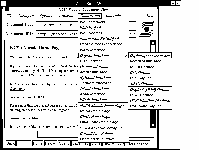
Figure 2-5 A Pre-release Version Of NCSA Mosaic For X.
In November 1993 NCSA released versions of Mosaic for the Microsoft Windows and
Apple Macintosh environment. These browsers, which are freely available to the
academic community, provided access to WWW for people who did not have access
to Unix and X-Windows systems.
Examples of Usage
A number of examples of how the World-Wide Web is currently being used are
given below. These are just a few examples of the many thousands of WWW
serices which are currently available.
Publishing Research Information
Figure 2-6 illustrates how CERN (the European Particle Physics Laboratory)
makes its technical papers available on the World-Wide Web. The URL for the
paper illustrated is
http://www1.cern.ch/ALICE/ENGINEERING/engineering.html
Figure 2-6 Example of Scientific Information Held At CERN.
Campus Wide Information Systems
The Honolulu Community College Campus Wide Information System (CWIS) was the
first multimedia CWIS on the World-Wide Web. The URL for this CWIS is
http://www.hcc.hawaii.edu/ 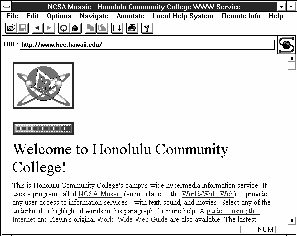
Figure 2-7 The Honolulu Community College CWIS.
Teaching Applications
The Globewide Network Academy (GNA) won a Best of the Web 1994 award for the
Introduction to Object Oriented Programming Using C++ distributed
teaching application. The URL for this application is
http://uu-gna.mit.edu:8001/uu-gna/text/cc/index.html 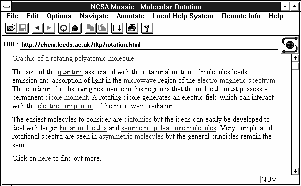
Figure 2-8 A Distributed Teaching Application.
Publicity
The School of Computer Studies at the University of Leeds was one of the first
departments to use the multimedia capabilities of WWW to market its courses to
potential students. The URL for this application is
http://agora.leeds.ac.uk/WWW/MSc/MSc_text/leeds.html 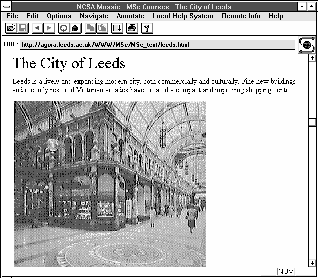
Figure 2-9 University of Leeds Prospectus Information.
Virtual Libraries
Many virtual libraries, art galleries and exhibitions are available on the
World-Wide Web. One of the first was the Vatican exhibition. The URL for this
virtual exhibition is
http://sunsite.unc.edu/expo/vatican.exhibit/Vatican.exhibit.html 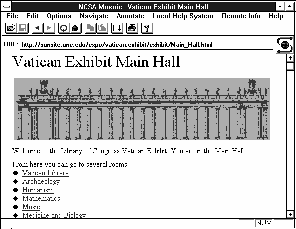
Figure 2-10 The Vatican Exhibition.
Commercialisation Of WWW
The World-Wide Web is increasingly being used by commercial companies. For
example the URL for the Pizza Hut ordering service is
http://www.pizzahut.com/
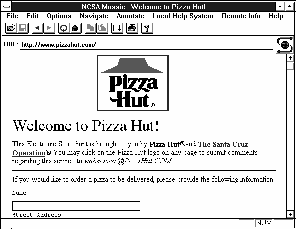
Figure 2-11 A Commercial Application On WWW.
Government Use Of WWW
The World-Wide Web is also being used by governmental agencies. For example
the URL for the CCTA is
http://www.open.gov.uk/ 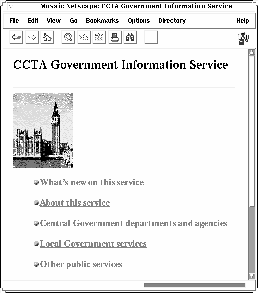
Figure 2-12 The CCTA Government Information Service.
Terminology
The following terms are used in this document:
3 World-Wide Web Browsers
In order to access the World-Wide Web you will need to use a browser (or
client). A wide range of clients are available for many different platforms:
although the Mosaic client is very popular you should not think that Mosaic
is the World-Wide Web.
Publicly Available Telnet Browsers
A number of browsers are publicly available which can be accessed using the
telnet protocol. These include:
telnet rsl.ox.ac.uk
Radcliffe Science Library & Bodleian Library WWW Server (p1 of 6)
RADCLIFFE SCIENCE LIBRARY & BODLEIAN LIBRARY WWW SERVER
UNIVERSITY OF OXFORD
[IMAGE]
Welcome! At present this WWW server is still feeling its way. This
page is intended primarily as a starting point for Oxford users
wishing to explore Internet services and information sources. From
this home page you can also access some of our Local WWW applications
which are for the most part still under development. For newcomers to
the Web, one good introduction is Entering the World-Wide-Web: A Guide
to Cyberspace by Kevin Hughes. Another is CERN's WWW FAQ (list of
Frequently Asked Questions).
Apologies to our regular Lynx users. We have phased out the old Lynx
opening page and you will now commence with this one. If you would
like to voice your opinions or your feelings, please feel free to use
the comments form below.
________________________________________________________________
-- press space for more, use arrow keys to move, '?' for help, 'q' to quit
Figure 3-1 The Client At Radcliffe Science Library.Text-Based Browsers
The browser illustrated in Figure 3-1 is a text-based browser (which is
sometimes referred to as a command-line browser). Text-based clients run on a
text-based operating system environment (e.g. DOS rather than Microsoft
Windows, or Unix rather than X Windows). Command line clients place less
demands on the local computer system, but do not provide the ease-of-use or
range of functionality provided by graphical clients.
Lynx
The most widely-used text-based browser is probably Lynx. Lynx was developed
at the University of Kansas, originally for Unix. An example of the Unix
implementation is illustrated in Figure 3-1. Availability
The Lynx browser software is available at the URL
ftp://ftp2.cc.ukans.edu/pub/Web/
In the UK it is also available at the URL
ftp://src.doc.ic.ac.uk/packages/WWW/lynx
NCSA Browsers
The NCSA Mosaic browser is available for the X Windows, Microsoft Windows and
Apple Macintosh environments.
NCSA Mosaic For X
Although it was not the first graphics browser, NCSA Mosaic For X helped to
popularise the Web. At the time of writing version 2.4 is available, although
a beta version of 2.5 is also available (which includes support for a number of
new features including hierarchical hotlists).NCSA Mosaic For Windows and the Macintosh
If NCSA Mosaic For X helped to popularise the Web, NCSA Mosaic For Windows and
for the Macintosh made it available to a much larger number of people. 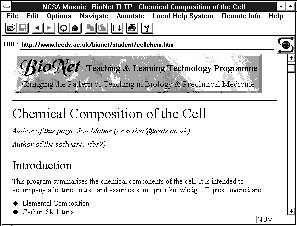
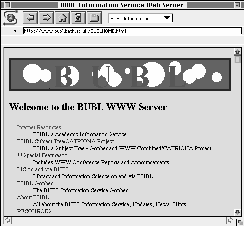
Figure 3-4 NCSA Mosaic For Windows and the Macintosh.
Availability
The NCSA Mosaic browser software for the X, Microsoft Windows and Apple
Macintosh platforms is available at the URL
ftp://ftp.ncsa.uiuc.edu/pub/Web/
In the UK it is available at the URL
ftp://src.doc.ic.ac.uk/packages/WWW/Mosaic/
Cello Browser
Cello was one of the first WWW browsers to be developed for the Microsoft
Windows environment. It was written by Thomas R Bruce of the Legal Information
Institute, Cornell University. Availability
The Cello browser software for Microsoft Windows is available at the URL
ftp://ftp.law.cornell.edu/pub/LII/Cello/
EINet Browsers
EINet have developed the WinWeb and MacWeb browsers for the PC and Apple
Macintosh platforms.

Figure 3-6 The WinWeb and MacWeb Browsers.
Availability
The EINet browsers software for the X, Microsoft Windows and Apple Macintosh
environments are available at the URL ftp://ftp.einet.net/einet/
Netscape Browsers
Netscape Communications Corporation (MCOM) was set up by Jim Clark, founder of
Silicon Graphics. MCOM recruited the developers of NCSA Mosaic to develop a
WWW browser. A beta release of Netscape was released in October 1994. It
generated a tremendous amount of interest, because of its speed and
functionality. However it also caused concern, since it included extensions to
the HTML standard which had not been part of the HTML standardisation
process.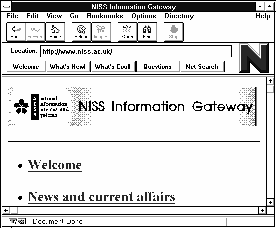
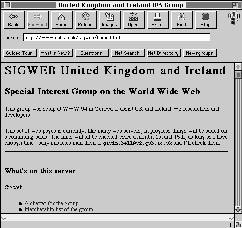
Figure 3-7 The Netscape Browser for Windows and the Macintosh.
Availability
The Netscape browser for the X, Microsoft Windows and Apple Macintosh
environments is available at the URL
ftp://ftp.mcom.com/
In the UK it is
available at the URL
ftp://src.doc.ic.ac.uk/packages/WWW/Netscape/
Further
information is available from the URL
http://home.mcom.com/home/welcome.html
Air Mosaic Browsers
Air Mosaic is another commercial browser which is based on the NCSA Mosaic
source code. 
Figure 3-8 The Air Mosaic Browser For Windows.
Availability
An evaluation copy of the Air Mosaic browser software for the X, Microsoft
Windows and Apple Macintosh environments is available at the URL
ftp://ftp.spry.com/demo/
Further information is available at the URL
http://www.spry.com/
GWHIS Browsers
GWHIS is a commercial WWW browser marketed by Quadralay. GWHIS (Global-Wide
Help and Information System) consists of a WWW browser, an application program
interface (API) for integrating GWHIS into applications and a search engine.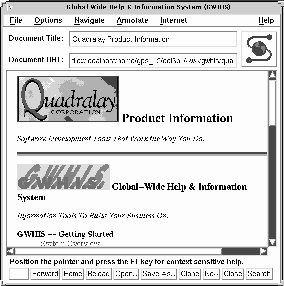
Figure 3-9 The GWIS Browser For X Windows.
Availability
An evaluation copy of the GWHIS browser software for the X, Microsoft Windows
and Apple Macintosh environments is available at the URL
ftp://ftp.quadralay.com/pub/gwhis
Further information is available at the URL
http://www.quadralay.com/
Other Browsers
Many other browsers are available or are currently being developed. Some of
the browsers are aimed at the business community. Of particular interest to
the academic community are the Internet browsers which are being developed by
Microsoft (for inclusion with Windows 95), IBM, Apple and Novell. 
Figure 3-10 The Warp OS/2 Browser.
Future Developments
A browser known as Arena is currently being developed which will handle HTML 3.
HTML 3 is a new version of HTML which contains a number of facilities which are
not available in HTML 2, including table handling and mathematical formulae. 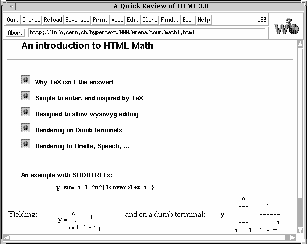
Figure 3-11 The Arena Browser.
Availability
Arena is currently a beta program. It can be obtained from the URL
ftp://ftp.w3o.org/
In the UK it is available at the URL
ftp://src.doc.ic.ac.uk/packages/www/arena
Further Information
A list of browsers is available at the URL
http://info.cern.ch/hypertext/WWW/Clients.html
Conclusions
Which is the best browser? There is no longer a simple answer to this. The
growth in the number of browsers, the different licensing arrangements and
different areas they address is making it difficult to adopt an institutional
policy on choosing a browser. At the time of writing the Netscape browser
looks very attractive. However it was developed primarily to address the needs
of commercial users, many of whom requested greater control over the appearance
of HTML pages in order to reflect a corporate identity. Will Netscape,
however, be as quick to support mathematical equations, which will be of
interest to most academic institutes? Will it be the best browser for
providing control over external applications - an area which is likely to be of
interest to academics who wish to develop distributed teaching materials?
4 HTML
About HTML
Native documents on the World-Wide Web are written in HTML, the HyperText
Markup Language. HTML defines the structural elements in a document (such
as headers, citations, addresses, etc.), layout information (bold and italics),
the use of inline graphics together with the ability to provide hypertext
links.
Figure 4-1 A Simple HTML Document.
<HTML>
<HEAD>
<TITLE>The World-Wide Web</TITLE>
</HEAD>
<BODY>
<H1>About The World-Wide Web</H1>
<P>Information about the World-Wide Web is available
<A HREF="http://info.cern.ch/hypertext/WWW/TheProject.html"> at
CERN</A>.</P>
</BODY>
</HTML>
Figure 4-2 A Simple HTML Document.HTML Authoring Tools
Initially information providers on the World-Wide Web used standard editors
such as vi and emacs to create HTML documents. As WWW grew in popularity
authoring tools were developed to assist information providers. This section
describes three authoring tools which are available for the Microsoft Windows
environment: HTML Assistant, HTML Hyperedit and HTMLEd.
HTML Assistant
HTML Assistant is a simple authoring tool which can be used to create and edit
HTML documents. Frequently Asked Questions about HTML Assistant is available
at the URL
http://cs.dal.ca/ftp/htmlasst/htmlafaq.html
HTML Assistant is available at the URL
ftp://ftp.cica.indiana.edu/pub/pc/win3/misc
In the UK it is available at the URL
ftp://src.doc.ic.ac.uk/packages/WWW/tools/editing/ms-windows/html-assistant
HTML Hyperedit
HTML Hyperedit (which was developed using the Toolbook authoring system) not
only provides an environment for producing HTML documents, but also contains a
tutorial which gives an introduction to HTML. HTML Hyperedit is available at
the URL
ftp://info.curtin.edu.au/pub/internet/mswindows/hyperedit
In the UK it is available at the URL
ftp://src.doc.ic.ac.uk/packages/WWW/tools/editing/ms-windows/win-htmledit
HTMLEd
HTMLEd is a simple authoring tool which can be used to create HTML documents.
In the UK it is available at the URL
ftp://src.doc.ic.ac.uk/packages/WWW/tools/editing/ms-windows/
Word Processing Tools
HTML Assistant and HTML Hyperedit are self-contained authoring tools. Another
approach is to develop authoring tools which work within a word processing
environment. These tools are normally implemented as macros for popular word
processing packages, such as Word For Windows or WordPerfect. This section
describes three tools which have been developed for use within Word For
Windows: the GT_HTML, CU_HTML and ANT_HTML macros.GT_HTML
One of the first word processing macros which could be used to create HTML
documents was the GT_HTML macro. This macro, written for Word For Windows, was
developed at the Georgia Technical Research Institute. In the UK the software
is available at the URL
ftp://src.doc.ic.ac.uk/packages/WWW/tools/editing/macros/ms-winword
CU_HTML
CU_HTML is a template designed to work within Word For Windows. The
template was written by Anton Lam (
mailto:anton-lam@cuhk.hk
) The software is
available at the URL
ftp://ftp.cuhk.hk/pub/www/windows/util
ANT_HTML
ANT_HTML is a template designed to work within Word For Windows 6.0.
The template was written by Jill Swift (
mailto:jswift@freenet.fsu.edu
) The
software is available at the URL
ftp://ftp.einet.net/einet/pc/ANT_HTML.ZIP

Figure 4-8 The ANT_HTML Macro.
Browser Editing Tools
Another approach to editing HTML documents is provided by browsers which are
integrated with editing tools. The Arena browser enables an external editor to
be invoked to edit the displayed HTML document. Figure 4-9 illustrates the
Arena browser used in conjunction with the Emacs editor. 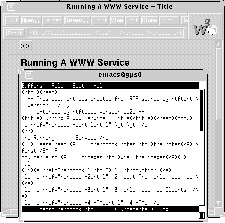
Figure 4-9 Editing A Document From Arena.
HTML Document Conversion Tools
Authoring tools are normally used to create new HTML documents. Document
conversion tools, on the other hand, can be used to convert existing documents
to HTML format.
LaTeX2html
One of the first sophisticated document conversion tools to be developed was
the LaTeX2html conversion program. This program was written by Nikos Drakos,
Computer Based Learning Unit, University of Leeds. It and set the standard for
document converters, providing a wide range of feature including:
Figure 4-10 illustrates a document which has been converted by the LaTeX2html
conversion program.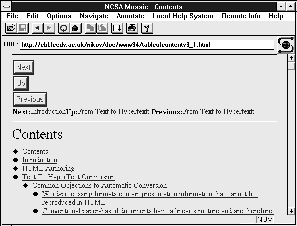
Figure 4-10 A Document Converted Using LaTeX2html.RTFtohtml
The RTFtohtml conversion program enables RTF files (which can be produced by
word processing packages such as Word For Windows) to be converted to HTML.
The program was written by Chris Hector(Cray) based on RTF parsing software
developed by Paul DuBois.
Figure 4-11 Document Converted Using RTFtoweb.HTML Quality Tools
The HTML specification states that "HTML parsers should be liberal except
when verifying code. HTML generators should generate strictly conforming
HTML." Put simply this means that browsers should be capable of displaying
documents which contain invalid HTML, but HTML authoring tools and document
converters should generate HTML which conforms strictly to the standard.HoTMetal
HoTMetaL is an HTML authoring tool and validator. It will provide feedback if
it encounters invalid HTML, as illustrated in Figure 4-12.Weblint
A tool called weblint can be used to check for invalid HTML documents.
This software is available from the URL
ftp://ftp.khoros.unm.edu/pub/perl/www/weblint-1.000.tar.gz
In the UK it is available at the URL
ftp://src.doc.ic.ac.uk/packages/WWW/tools/weblint
SGMLS
sgmls is a tool which can be used to validate SGML documents. It is
available at the URL
ftp://sgml1.ex.ac.uk/pub/SGML/sgmls/
sgmls is used in a
number of HTML validation services, such as those mentioned above. Information
on installing sgmls and also pgmls (an SGML mode for emacs) is available
at the URL
http://web.nexor.co.uk/users/mak/doc/html/sgml-lib/html-sgml.html
HTML Validation Service
An HTML validation service is available at the URL
http://www.hal.com/%7Econnolly/html-test/service/validation-form.html
This service makes use of HTML forms and a CGI script which runs a HTML
validation program. The service can be used to check HTML syntax by entering
the HTML markup to be checked. It can also be used to check an existing HTML
document by entering the URL of the document.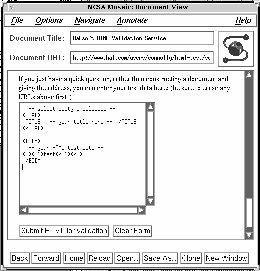
Figure 4-13 HTML Validation Service.HTML Check Toolkit
The HTML Check Toolkit is another HTML validation program. The software can be
installed using a WWW browser. The installation service, illustrated below, is
based on the EIT Webmaster Starter's Kit. HTML Check Toolkit is available at
the URL http://www.hal.com/~markg/HaLSoft/html-check/

Figure 4-14 Installing The Check_HTML Script.
Review of HTML Tools
Before choosing HTML authoring tools, document converters or quality tools for
institutional use the following issues should be considered:Writing Style
Writing styles for WWW documents are still developing. However there are a
number of guidelines which can be provided:
Finding Out More About HTML
This document does not provide an in-depth tutorial on HTML. Many WWW
resources are available which give details on writing HTML. Some of these are
listed below:
In addition to these documents the following resources are also available.
5 Graphics
The World-Wide Web is, of course, a graphical system. This section describes
how graphical objects can be incorporated in an HTML document, how external
graphical files can be used and how to create and use interactive maps. The
section also considers the performance aspects of using graphics.
HTML Graphical Tags
Inline images are defined in an HTML document using the <IMG> tag. For
example:Using External Viewers
You can use the <A> anchor tag to refer to a graphical file. When the
link is selected the graphical file is normally passed to a graphical viewer
(such as xv or LVIEW) for displaying.Active Maps
An active map (also sometimes refered to as a clickable image) is
an inline image in an HTML document. An area of the image can be selected,
usually by clicking with a mouse. The coordinates of the image that has been
selected are sent to a program which can then process the information. An
active map can be used to provide a graphical menu, in which selecting a menu
option will retrieve a specified HTML document. Active maps can also be used
in developing teaching and learning software - for example a medical student
could be asked to click on an area of an xray which shows a cancerous growth.
If an incorrect area is selected a HTML document giving further information can
be displayed.
<A HREF="cgi-bin/htimage/xray.config">
<A IMG SRC="xray.gif" ISMAP></A>
Figure 5-1 HTML Document Containing Markup For An Active Map.
rectangle (100,100) (500,500) cancer.html
circle (50,50) 25 homepage.html
Figure 5-2 Configuration File For Active Map.Mapedit
Mapedit is an editor for creating image map files. Image map files are
a feature of NCSA and CERN servers; they enable you to turn a GIF image into a
clickable map by designating areas using polygons and circles within the GIF
and specifying a destination URL for each area. The software is not public
domain. Commercial users must pay a licence fee; non-profit and educational
users are asked to send the author a postcard. The software is available from
the URL
ftp://sunsite.unc.edu/pub/packages/infosystems/WWW/tools/mapedit
In the UK it is available at the URL
ftp://src.doc.ic.ac.uk/packages/WWW/mapedit
Mapedit was written by Thomas Boutell
(mailto:boutell@netcom.com). Graphical Tools
Paintshop Pro
Paintshop Pro is an example of a Microsoft Windows tool which can be used to
manipulate graphics files for use on WWW. Paintshop Pro can be used to convert
file formats, to reduce colour depth and to convert colours.Other Graphical Tools
Imagizer can generate high-quality thumbnail images, among other things,
on-the-fly. It is available for SunOS, Solaris, and HPUX, and soon for
Windows and NT. Further details are available at the URL
http://pc.inrird.com/imagizer.html
Appropriate Use Of Graphics
Novice information providers may be tempted to fill their HTML documents with
inline graphical images. More experienced computer users will remember the
large numbers of poorly designed paper documents which were produced once
desktop publishing packages became widely used.
Look at the following URL. See how long it takes for the information to be
delivered. Note that if you retry the URL it is likely to be quicker if it is
cached by your client or by your server (if your server supports caching).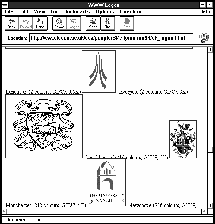
Figure 5-5 UK University Logos.Further Information
A tutorial on imagemaps is available at the URL
http://wintermute.ncsa.uiuc.edu:8080/map-tutorial/image-maps.html
6 Searching And Indexing
The tremendous growth in the numbers and extent of information services on WWW
has made net-surfing an ineffective way of finding useful information.
Fortunately sophisticated indexing tools are being developed. Figure 6-1 shows
a page which contains pointers to a number of searching tools. 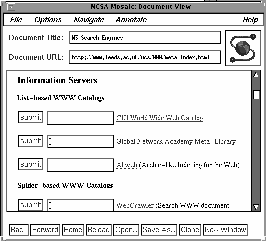
Figure 6-1 A Collection Of WWW Search Engines.
Robots, Spiders and Worms
During 1993 many WWW users discovered resources by net-surfing: going to
one WWW server, exploring what was available, and then following links to other
WWW servers. A number of software developers produced software which automated
this process, so that a program went from server to server, indexing
information, such as contents of the <TITLE> tag or the contents of
server home pages. Such programs became known as robots or spiders; one robot
was called WWWW, the World-Wide Web Worm.
A number of these issues have been addressed. Martijn Koster's Guidelines
For Robots, which is available at the URL
http://web.nexor.co.uk/mak/doc/robots/robots.html
provides guidelines for developers of robots. Aliweb
Aliweb (Archie Like Indexing In The Web) provides another approach to the
indexing of WWW resources. With Aliweb each site is responsible for indexing
files. The server administrator is responsible for choosing the files to be
indexed. SWISH
SWISH, which stands for Simple Web Indexing System for Humans, was announced on
16 November 1994. It is a program that allows you to index your Web site and
search for files using keywords in a fast and easy manner. Documentation is
available at the URL
http://www.eit.com/software/swish/swish.html
The software is available at the URL
ftp://ftp.eit.com/pub/web.software/swish/
WAIS
WAIS (Wide Area Information Server) is another mechanism for indexing
resources. WAIS is used by the Computing Service, University of Leeds to index
its documents and newsletters. An example of how the WAIS server and WAIS
indexing software is used is given below.WAIS Utilities
A number of utilities are available which can post-process the output from
WAIS.
Documentation is at the URL
http://www.eit.com/software/wwwwais/wwwwais.html
A WAIS Application
One interesting application of the use of WAIS is the multimedia archive
prototype developed by Andy Walker, formerly of the CBL/Multimedia Unit,
University of Leeds. The prototype was developed to investigate the
feasability of providing a archive of multimedia objects for use in CBL
applications by members of the University of Leeds.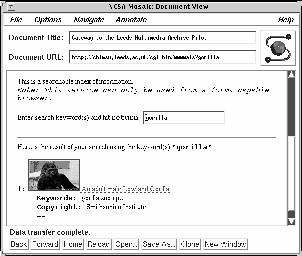
Figure 6-2 Multimedia Archive.
Which WAIS?
A number of WAIS servers are available. The freeWAIS software is
currently used at the University of Leeds. This software is maintained by
CNIDR, the Clearinghouse For Networked Information Discovery and Retrieval.
The freeWAIS software, however, is based on the 1988 version of the Z39.50
protocol. An implementation of WAIS based on the 1992 version of Z39.50 is
also believed to be available from CNIDR. freeWAIS is available at the URL
ftp://ftp.cnidr.org/pub/NIDR.tools/freewais
CNIDR Isite
CNIDR Isite is an integrated software package including a text indexer, search
engine and Z39.50 communication tools to access databases. Isite includes the
CNIDR ZDist, Isearch and Search API distributions. Further Information
A tutorial on Mosaic and WAIS is available at the URL
http://wintermute.ncsa.uiuc.edu:8080/wais-tutorial/wais.html
7 WWW Servers
If you wish to make information available you will need to run a WWW server.
The server software is known as httpd - the hypertext transport protocol
daemon. Just as their many WWW browsers available there are also many servers,
including ones for Unix, MS Windows, Windows NT and the Apple Macintosh.Example of Installing A Server On A PC
An example illustrating how easy it is to install a WWW server is given below.
The example assumes that you have access to a networked PC.
image
cd /Web/ncsa/httpd/Windows/winhttpd
get whtpp13p1.zip
Figure 7-1 Running The Windows HTTPD Server. Figure 7-2 Accessing The MS Windows HTTPD Server.
Figure 7-2 Accessing The MS Windows HTTPD Server.Server Configuration Files
World-Wide Web server software will normally have a configuration file which is
used to:
As WWW develops, additional features will be provided in the server software
and the configuration files are likely to grow in complexity. An example of a
simple configuration file is shown below.
map /* file:/apps/WWW/*
pass file:/apps/WWW/*
fail *
Figure 7-3 A Simple httpd.conf Configuration File
serverid www.leeds.ac.uk
mask @(129.11.*.*)
}
protect http:* prot-proxy # Part 2
protect gopher:* prot-proxy
protect ftp:* prot-proxy
protect wais:* prot-proxy
pass http:* # Part 3
pass gopher:*
pass ftp:*
pass wais:*
Exec /cgi-bin/ucs/* /apps/WWW/cgi-bin/ucs/* # Part 4
Exec /cgi-bin/bionet/* /apps/WWW/cgi-bin/bionet/*
Exec /cgi-bin/bmb/* /apps/WWW/cgi-bin/bmb/*
map / file:/apps/WWW/homepage.html # Part 5
map /* file:/apps/WWW/*
pass file:/apps/WWW/*
fail *
AccessLog /var/adm/httpd.log # Part 6
LogFormat Common
LogTime LocalTime
Caching On # Part 7
CacheRoot /usr/info/WWW_cache
CacheSize 300
CacheAccessLog /var/adm/httpd_cache.log
# Delete files from cache after specified number of days
CacheClean http:* 10 Days
CacheClean gopher:* 10 Days
CacheClean wais:* 10 Days
CacheClean ftp:* 10 Days
# Don't cache local files # Part 8
NoCaching http://*.leeds.ac.uk/*
# If a file hasn't been accessed within the last specified
# number of days delete from cache
CacheUnused * 5 days
CacheUnused http://info.cern.ch/* 10 days
CacheUnused http://www.ncsa.uiuc.edu/* 10 days
# ensure dynamically changing documents are only kept for short
# periods e.g. one modified 10 days ago will only last 2 days
CacheLastModifiedFactor 0.2
# If a file was retrieved more than 5 days ago do a
# 'conditional get' request to the source server to check
# that it hasn't been updated in the meantime.
CacheRefreshInterval http://* 5 days
CacheRefreshInterval gopher://* 5 days
CacheRefreshInterval ftp://* 5 days
# CacheDefaultExpiry ensures that Gopher and FTP files are
# cached. The default is 0 which is what we want for http
# documents with neither an expiry nor a last-modified stamp.
CacheDefaultExpiry ftp://* 5 days
CacheDefaultExpiry gopher://* 5 days
# Remove unwanted cached files daily at 3 am (garbage collection).
Gc On
GcDailyGc 3:00
Figure 7-4 A httpd.conf Configuration File
abc_pc99.leeds.ac.uk - - [21/Nov/1994:21:59:47 +0000] "GET
http://www.leeds.ac.uk/ HTTP/1.0" 200 2782
abc.nt.com - - [21/Nov/1994:22:00:03 +0000] "GET
/music/NetInfo/MusicFTP/ftp_sites.html HTTP/1.0" 200 13175
Figure 7-5 Example of a httpd.log File.Caching
Many clients provide client-side caching. This means that if you retrieve a
file and then retrieve another file, when you return to the initial file it
will be retrieved from the client's cache, thus saving a subsequent network
transfer.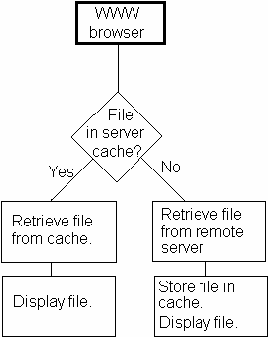
Figure 7-6 Caching By The Server.
gopher_proxy: www.leeds.ac.uk
wais_proxy: www.leeds.ac.uk
xyz_pc77.leeds.ac.uk - - [21/Nov/1994:00:43:38 +0000] "GET
http://white.nosc.mil/gif_images/glacier_s.gif HTTP/1.0" 200 6474
xyz_pc77.leeds.ac.uk - - [21/Nov/1994:00:43:40 +0000] "GET
http://white.nosc.mil/gif_images/rainier_s.gif HTTP/1.0" 200 18749
Figure 7-8 The httpd_cache Log File.Caching Strategies
As well as using a local server cache, it is also possible to use a national
caching service. The Unix HENSA service at the University of Kent at
Canterbury run a national caching service. To use this service the local
client should define www.hensa.ac.uk as the proxy.
Another national caching service is available at sunsite.doc.ic.ac.uk Further
information is available at the URL
http://src.doc.ic.ac.uk/WWW-Cache.html
Proxy Gateways
In many academic institutions off-campus access to the Internet is restricted
to authorised computers. Depending on the institution's local policy,
authorisation may be restricted to computers located in offices in which there
is an individual who is responsible for use of the machine. Such a policy may
be enforced in order to provide some means of security against hacking remote
services. However this policy would appear to prevent students from accessing
remote information services from computers in open access cluster areas.Further Information
Further information on caching and proxies is available at the following
URLs:
Security
The httpd server also handles a number of security issues. It is common
practice to restrict access to a certain area of the filestore. For example if
the server configuration files contains the lines:
pass file:/apps/WWW/*
fail *
Figure 7-9 Server Configuration File.
The method of implementing such security tends to be server dependent, and will
not be described in this document.
Summary of Server Software
A brief summary of server software is given below. This summary is based on
Thomas Boutell's WWW FAQ.
Unix Servers
CERN httpd
Information about CERN's server is available at the URL
http://info.cern.ch/hypertext/WWW/Daemon/Status.html
NCSA httpd
NCSA's server is available at the URL
ftp://ftp.ncsa.uiuc.edu/Web/ncsa_httpd
EIT httpd
EIT have created a Webmaster's Starters Kit which installs their server
using a forms interface from a WWW browser. Further information is available
at the URL
http://wsk.eit.com/wsk/doc/
GN Gopher/http
The GN server can serve both WWW anbd Gopher clients. It may be useful for
sites wishing to migrate from Gopher to WWW, although it does not have the
server-script capabilities of the CERN and NCSA servers. Further information
is available at the URL
http://hopf.math.nwu.edu/
Plexus perl server
The Plexus server is written in Perl. Further information is available at the
URL
http://bsdi.com/server/doc/plexus.html
WebWorks Enterprise server
The is a commercial server marketed by Quadralay Inc. Further information is
available at the URL
http://www.quadralay.com/products/WebWorks/Server/index.html
Netsite Communication Server and Netsite Commercial
Server
These servers have been developed by Netscape Communications Corporation.
Further information is available at the URL
http://home.mcom.com/MCOM/products_docs/server.html
Macintosh Servers
MacHTTP
Information about the MacHTTP server for the Apple Macintosh is available at
the URL
http://www.biap.com
Novell Netware Servers
httpdnlm
The httpd NLM server for Novell Netware is available at the URL
ftp://ftp.glaci.com/pub/netware/http/
Microsoft Windows and Windows NT Servers
https
HTTPS is a Windows NT server developed at Edinburgh University which runs on
Intel, MIPS and Alpha CPUs. It is available at the URL
ftp://emwac.ed.ac.uk/pub/https/
NCSA httpd For Windows
The NCSA httpd for Windows server provides
most of the features of the Unix version, including scripts (which generate
pages on the fly). It is available at the URL
ftp://ftp.ncsa.uiuc.edu/Web/ncsa_httpd/contrib/
SerWeb
SerWeb is a Microsoft Windows server. It is available at the URL
ftp://emwac.ed.ac.uk/pub/serweb/
Web4Ham
Web4Ham is a Microsoft Windows server. It is available at the URL
ftp://ftp.informatik.uni-hamburg.de/pub/net/winsock/
Server Strategies
An institution needs to decide on its server strategies. For example, should
it support:
If option 2 is chosen then how is indexing across servers to be achieved, and
what caching strategy is to be adopted. What are the skills levels needed by
the server administrator? An institution, such as a university, needs to
recognise that adopting a server strategy is more than simply installing the
server software.
Which Server?
The most widely used servers are probably those developed at CERN and NCSA for
the Unix platform. Unix is probably the best platform for running an
institutional WWW service, since it is a mature, pre-emptive multi-tasking
operating system. In addition, Unix provides a wide range of tools which can
be used to assist in system administration. Servers are available for the PC
and Macintosh platform, but, due to the inherent deficiencies in the operating
system environments which are currently used on the platform, such servers are
probably not recommended if you wish to run a large-scale, stable service.Further Information
Further information about HTTP is available at the URL
http://info.cern.ch/hypertext/WWW/Protocols/
8 Extending WWW
External Viewers
Access to WWW can be achieved by using a client such as NCSA Mosaic to display
HTML documents and inline images in GIF format. However the World-Wide Web is
an extensible system: clients can access information which is in other formats
than HTML.
File Format Viewer
JPEG LVIEW (MS Windows) xv (X Windows)
Postscript Ghostview
DVI xdvi (X Windows)
MPEG mpeg_play (X Windows and MS
Windows)
Table 8-1 Popular Viewers.
TYPE0="audio/wav"
TYPE1="application/postscript"
TYPE2="image/gif"
TYPE3="image/jpeg"
TYPE4="video/mpeg"
TYPE5="video/quicktime"
TYPE6="video/msvideo"
TYPE7="application/x-rtf"
TYPE8="audio/x-midi"
TYPE9="audio/basic"
TYPE10="image/x-action"
TYPE11="application/x-w3launch"
application/postscript="L:\winapps\ghost\gsview %ls"
application/x-w3launch="n:\windept\bmb\w3launch\w3launch %ls"
image/gif="L:\winapps\mosaic2\lview %ls"
image/x-action="n:\windept\bmb\action25\playact %ls"
image/jpeg="L:\winapps\mosaic2\lview %ls"
video/mpeg=""
video/quicktime=""
video/msvideo=""
audio/wav=""
audio/x-midi="mplayer %ls"
application/x-rtf="write %ls"
Figure 8-1 Part of a MOSAIC.INI File.Running Client Applications
If a Postscript file is retrieved from a WWW server the browser program
normally responds "I don't know what to do with a Postscript file - but I
know a program that does. I'll pass the Postscript file on to the Ghostview
program". If, for example, an Excel spreadsheet is retrieved from a WWW
server the client could be configured to respond "I don't know what to do
with an Excel spreadsheet file - but I know a program that does. I'll pass the
spreadsheet file on to the Excel program". This technique extends the
functionality of the World-Wide Web from acting as a distributed file viewer to
acting as a distributed program manager.
Security Implications
Unfortunately there are a number of security concerns with such an approach.
For example an application developed using the Toolbook authoring system could
be delivered using WWW. The application could then be launched using a local
copy of Toolbook. The application could have a button marked Start.
Clicking this button could then result in files held on the local machine being
deleted! Even associating a word processed document with Word For Windows
holds dangers, as many Microsoft applications, including Word For Windows,
support the use of macros, including autostart macros, which could also cause
files to be deleted.Implementing Security - W3Launch
There are security problems in using a WWW browser to download and run software
from the Internet. It is generally not considered wise to configure a
browser so that it recognises file types which contain programs. Jon Maber,
Biochemistry and Molecular Biology, University of Leeds has developed a
launching program for the Bionet TLTP project which provides a simple and
secure method of launching only authorised software.Server-side Extensions
Example
The previous section described how it is possible to run applications on the
client machine. It is also possible to run software on the server. A simple
application running on the server is shown in Figure 8.3.
echo Content-type: text/html
echo
if [ $# = 0 ]
then
echo "<HEAD>"
echo "<!-- Script written by Brian Kelly --!>"
echo "<TITLE>Search University Phone Directory</TITLE>"
echo "<ISINDEX>"
echo "</HEAD>"
echo "<BODY>"
echo "<H1>Phone Directory</H1>"
echo "Enter surname of the person you are searching for.<P>"
echo "Script written by <A HREF=http://www.leeds.ac.uk/
ucs/people/BKelly/bk.html>Brian Kelly</A>."
echo "</BODY>"
else
echo "<HEAD>"
echo "<TITLE>Results Of Search</TITLE>"
echo "</HEAD>"
echo "<BODY>"
echo "<H1>Results of Search for $* </H1>"
echo "<PRE><TT>"
grep -i "$*" /apps/data/Telephone_Directory
echo "</PRE></TT>"
echo "</BODY>"
fi
Figure 8-3 Script To Generate An HTML Document.
<!-- Script written by Brian Kelly --!>
<TITLE>Search University Phone Directory</TITLE>
<ISINDEX>
</HEAD>
<BODY>
<H1>Phone Directory</H1>
Enter surname of the person you are searching for.<P>
Script written by <A HREF=http://www.leeds.ac.uk/
ucs/people/BKelly/bk.html>Brian Kelly</A>.
</BODY>
Figure 8-4 Virtual HTML Document.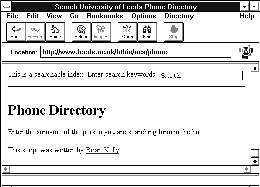
Figure 8-5 Running The Script.
Figure 8-6 Output From The Script.
CGI Programs
The example described above is known as a CGI program. CGI stands for the
Common Gateway Interface. It is a standard which has been adopted by a
number of server developers (primarily developers of the CERN and NCSA server
software) for running programs on the server machine. A definition of CGI is
available at the URL
http://hoohoo.ncsa.uiuc.edu/cgi/examples.html
Forms
Forms are often used to collect the information from a user which is used as
input to a CGI program. A description of forms is given below.
Creating A Form
A form consists of areas of the screen in which the user can input data. The
data is sent to the HTTP server, which can run a script or program to process
the data in some way. One common use of forms is to provide feedback on a WWW
service. Input to the form can be emailed to the service administrator. Forms
can also be used to input search criteria to be input to a search engine, or to
specify parameters for distributed teaching and learning services.
<H1>Fill-Out Form Example #7</H1>
This is another fill-out form example, with toggle buttons. <P>
<HR>
<FORM METHOD="POST"
ACTION="http://hoohoo.ncsa.uiuc.edu/htbin-post/post-query">
<H2>Godzilla's Pizza -- Internet Delivery Service, Part II</H2>
Type in your street address: <INPUT NAME="address"> <P>
Type in your phone number: <INPUT NAME="phone"> <P>
Which toppings would you like? <P>
<OL>
<LI> <INPUT TYPE="checkbox" NAME="topping" VALUE="pepperoni">
Pepperoni.
<LI> <INPUT TYPE="checkbox" NAME="topping" VALUE="sausage">
Sausage.
<LI> <INPUT TYPE="checkbox" NAME="topping" VALUE="anchovies">
Anchovies.
</OL>
How would you like to pay? Choose any one of the following: <P>
<OL>
<LI> <INPUT TYPE="radio" NAME="paymethod" VALUE="cash" CHECKED>
Cash.
<LI> <INPUT TYPE="radio" NAME="paymethod" VALUE="check"> Check.
<LI> <I>Credit card:</I>
<UL>
<LI> <INPUT TYPE="radio" NAME="paymethod" VALUE="mastercard">
Mastercard.
<LI> <INPUT TYPE="radio" NAME="paymethod" VALUE="visa"> Visa.
<LI> <INPUT TYPE="radio" NAME="paymethod"
VALUE="americanexpress">
American Express.
</UL>
</OL>
Would you like the driver to call before leaving the store? <P>
<DL>
<DD> <INPUT TYPE="radio" NAME="callfirst" VALUE="yes" CHECKED>
<I>Yes.</I>
<DD> <INPUT TYPE="radio" NAME="callfirst" VALUE="no">
<I>No.</I>
</DL>
To order your pizza, press this button: <INPUT TYPE="submit"
VALUE="Order Pizza">. <P>
</FORM>
Figure 8-7 HTML Document Defining A Form.Processing A Form
Once the form is submitted the data which has been entered is appended to the
end of the URL given in the ACTION attribute of the FORM tag. This information
is then processed by the script.
Further Information About Forms
Forms tutorials are available at the URL
http://www.ncsa.uiuc.edu/SDG/Software/Mosaic/Docs/fill-out-forms/overview.html,
http://hoohoo.ncsa.uiuc.edu/docs/cgi/forms.html,
http://www.webcom.com/html/tutor/forms/start.html
and
http://kuhttp.cc.ukans.edu/info/forms/forms-intro.html
9 Utilities
A number of useful utility programs have been developed which will assist
systems managers and information providers.
10 Legal and Ethical Issues
Is your WWW service legal? Who is legally responsible for the contents of a
WWW service? Is pornography acceptable on a WWW service? If not, who defines
what is pornographic and what is art? How do you reconcile control over the
contents of a WWW server with intellectual freedom?
Liability
It could be argued that the contents of a WWW service are the responsibility of
the organisation which runs the service. So if an undergraduate has been
granted to publish information and publishes libellous information the
University may be legally responsible. An editorial in the Times Higher
Education Supplement suggested that if the organisation has published
guidelines covering acceptable and unacceptable use the organisation will have
a strong defence if a case is brought to law.
Computer Misuse Act
It is likely that any material which incites, encourages or enables others to
gain unauthorised access to a computer system would be found illegal under this
act.
Pornography
Are pictures of naked women acceptable on a WWW service? It could be argued
that similar guidelines which govern the contents of a University library
should be developed for the WWW. Are pictures of naked women acceptable in
books in the university library? The answer is probably "yes", especially if
the university has a fine art department. Similar arguments could be made for
textual pornography.Copyright, Designs and Patents Acts
In general the Copyright, Designs and Patents acts require that the permission
of the owner of the intellectual property must be sought before any use
of it is made whatsoever.Data Protection Act
Information about individuals which is available on WWW may have to be
registered with the Data Protection Officer. The information provider may have
to abide by regulations to ensure the accuracy of the information.
Equality Of Access To Information
WWW can provide global access to a wide range of information services. However
including large logos and graphical icons on pages can act as a barrier to
access to the information, especially for readers in developing countries will
limited network access. In some developing countries access may be provided
over local telephones lines. A health worker in a hospital in Africa who
wishes to retrieve information about public health services may have to pay the
additional in retrieving unnecessary graphics. If the local telephone company
is owned by a multinational telephone corporation then accessing the
information will result in a transfer of money from the developing country to
the multinational corporation.
Advertising
As shown in Figure 10-1 some WWW service providers have sponsors for their
pages. Is this currently acceptable within the UK academic community? Should
it be acceptable? 
Figure 10-1 The "What's New On Mosaic" Page.
JANET Acceptable Use Policy
UK universities which make use of JANET (the Joint Academic Network) must abide
by the rules and regulations governing he use of JANET. The following point
should be noted.
What Is Your WWW Service For?
Formulating an institutional acceptable use policy for WWW information
providers may not be a simple task. There are likely to be lively discussions
over censorship and control. The formulation of the policy will be helped if
the institution has a clear idea of what it expects from its WWW service. Is
it:
FurtherInformation
An interactive document called Sex, Censorship and the Internet is
available at the URL
http://www.eff.org:80/CAF/cafuiuc.html
This document asks
questions such as should universities carry alt.sex Usenet groups and should
students be punished for using vulgarities on the Net. The document provides
pointers to case studies.
11 CWISes And WWW
WWW is an ideal system for developing a campus (or community) wide information
system (CWIS). The world's first multimedia CWIS was developed at the Honolulu
Community College and officially announced at the end of May 1993. It is
available at the URL
http://www.hcc.hawaii.edu
Finding Out More
Papers by Judy Hallman about CWISes are available at the URL
ftp://sunsite.unc.edu/pub/docs/about-the-net/cwis/cwis-l
and
ftp://sunsite.unc.edu/pub/docs/about-the-net/cwis/hallman.txt
12 Teaching And Learning On WWW
Although WWW was initially used as a distributed multimedia system techniques
such as CGI scripts meant that interaction could be built into WWW
applications. Much of the interest in the WWW within the academic community is
based on its potential for developing distributed teaching and learning
software rather than simply delivering information.
Examples of Teaching And Learning On WWW
An early example of a distributed multimedia teaching prototype was developed
by Ben Whitaker, School of Chemistry, University of Leeds in 1993. As can be
seen in Figure 12-1 this prototype is a simple hypertext application. It is of
interest because it illustrates how distributed teaching applications
can be developed.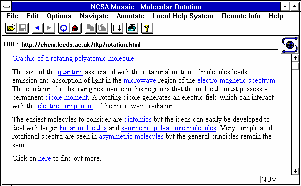
Figure 12-1 Early Example Of A Distributed Multimedia Teaching
Application.
Figure 12-2 Using a MIME Chemistry Type.CD ROM Facilities
Providing teaching and learning services on WWW does not necessarily deny
access to those who do not have a network connection. Teaching and learning
services developed on WWW can be transferred to a CD ROM and used on a
standalone system. Such systems are typically developed so that there is a
closed set of links. The files (which could include HTML documents, image,
sound and video files) and the WWW browser software can then be transferred
onto a CD ROM. This approach provides an updateable service for users with
network connectivity together with a fixed service for users with access to a
PC or Macintosh with a CD ROM player.
National Resources
A number of TLTP (Teaching and Learning Technology Programme), CTI (Computers
in Teaching Initiative) and ITTI (Information Technology Training Initiative)
projects are using WWW to disseminate information about their projects or, in
some cases, to deliver their courseware. Further Information
Further information about a mailing list for teaching and learning is available
at the URL
http://tecfa.unige.ch/edu-ws94/ws.html
13 Collaboration On WWW
WWW was originally envisaged by Tim Berners-Lee as a groupware tool. In
practice it grew in popularity as a publishing tool. However software
developers are now working on tools which will facilitate collaboration on WWW.
A brief summary of some of the collaborative tools is given below.
Asynchronous Systems
WIT
WIT, the WWW Interactive Talk system, was announced shortly after the
WWW 94 conference in CERN. WIT can be accessed at the URL
http://info.cern.ch/wit
Access To Usenet
The Netscape browser can be used to post to Usenet newsgroups.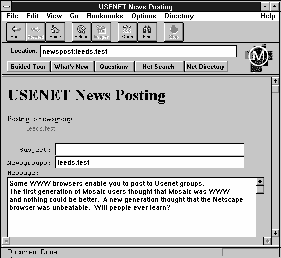
Figure 13-2 Posting To Usenet News.
Hypermail
Hypermail is a utility which can be used to convert mail archives to hypertext
format on WWW. A example of a hypermail archive is illustrated below. 
Figure 13-3 A Hypermail Archive.
Mailserv
Mailserv provides a forms interface to a number of mailing list servers. The
software is available at the URL
http://iquest.com/~fitz/www/mailserv/
The software was written by Patrick M Fitzgerald
(mailto:pmfitzge@iquest.com) 
Figure 13-4 The Mailserv Interface To Mailing List Servers.
Synchronous Systems
Video conferencing facilities are being developed which can be integrated with
WWW. 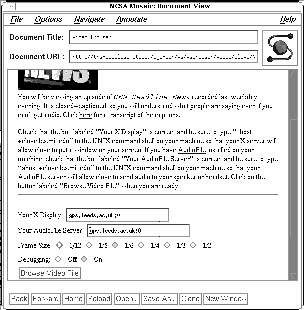
Figure 13-5 Accessing A Video On WWW.Virtual Conferences
One form of collaboration within the academic community is through conferences,
workshops and seminars. Whenever the author gives a paper at a conference or
is involved in running a workshop or a course he makes his papers, OHP foils,
etc. available on WWW under his personal page (sometimes referred to as a
vanity page). Further Information
A collection of WWW collaborative projects is available at the URL
http://union.ncsa.uiuc.edu/HyperNews/get/www/collaboration.html
14 Libraries And WWW
University Libraries should have a strong interest in WWW developments. This
handbook provides a overview of the World-Wide Web which should be of interest
to libraries which are considering using WWW.
Example Of A Gateway To A Library Catalogue
In the UK many university library catalogues are held in proprietary systems
with old-fashioned user interfaces. It may be possible, however, to use WWW to
provide an interface to the library catalogue which is consistent with other
information services on WWW. At the University of Leeds a backup copy of the
library catalogue is kept on a central Unix system using the BRS free text
retrieval system. A gateway program, has been developed by
Terry Screeton,
Computing Service which provides access to the Library catalogue. This
gateway is available at the URL
http://www.leeds.ac.uk/library/cats/backup.html

Figure 14-1 Gateway To A Library Catalogue.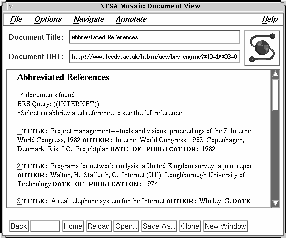
Figure 14-2 Output From The Library Catalogue.
Resources
Datalib provides an interface to a number of online information service
hosted at Edinburgh University. It can be accessed at the URL
http://datalib.ed.ac.uk/
Finding Out More
Web4Lib is a mailing list aimed at library-based WWW managers and developers.
To subscribe to the list email listserv@library.berkeley.edu with the
message SUBSCRIBE Web4Lib yourname.
15 Future Developments
This handbook describes how to run a WWW service using the technology which is
available today. However the technology is developing so rapidly that it is
important that WWW managers and information providers are aware of developments
which may happen sooner rather than later.
Uniform Resource Identifiers
Uniform Resource Locators (URLs) describe the location of a resource on
the Internet and the protocol which is used to access the resource. An object
on WWW may be available in many locations: for example popular browsers, such
as NCSA Mosaic, are available from anonymous FTP servers in many locations
around the world. The mirroring of files helps to minimise network traffic
over busy links, such as the trans-Atlantic link. Mirroring also reduces the
load on the central server. Uniform Resource Names (URNs) will provide
a mechanism for uniquely identifying a resource. In the future it is likely
that a browser will request a URN rather than a URL. A URN to URL resolver
will locate the nearest object (nearest in network terms).New Facilities
CCI
NCSA Mosaic For X (version 2.5) provides support for CCI (Common Client
Interface). This will provide a standard mechanism by which WWW browsers can
communicate with external programs. A number of demonstrations of this
facility are available, including a slideshow program, which instructs Mosaic
to display URLs which are specified in a file. A program called xwebteach
provides a mechanism by which a teacher can control the display of Mosaic on
student's machines. Further information about the CCI specification is
available at the URL
http://www.ncsa.uiuc.edu/SDG/Software/Mosaic/Docs/cci-spec.html
W3A
W3A (World-Wide Web Applets) is a proposal for a standard API for dynamically
linking applets (which can be defined as a piece of software that can be
attached to a host program such as a WWW browser). Further information is
available at the URL
http://www.let.rug.nl/~bert/W3A/W3A
Appendix 1 Mailing Lists
This section contains information on mailing lists and Usenet groups on topics
related to the World-Wide Web.Usenet News
comp.infosystems.www.users
comp.infosystems.www.users
provides a forum for discussion of WWW
client software (such as Mosaic, Cello and Lynx), new user questions, client
setup questions, client bug reports, resource discovery questions on how to
locate information on WWW that can't be found by the FAQ and comparisons
between various client packages are among the acceptable topics for this group.
comp.infosystems.www.providers
comp.infosystems.www.providers provides a forum for the
discussion of WWW server software and the use of server software to provide
information to users. General server design, setup questions, server bug
reports, security issues, HTML page design and other concerns of information
providers are among the likely topics for this group.
comp.infosystems.www.misc
comp.infosystems.www.misc provides a general forum for discussing
WWW issues which are not covered by the other comp.infosystems.www groups.
comp.infosystems.announce
comp.infosystems.announce is for announcement of new information
services (e.g. new WWW sites) and new software products (new server software,
new clients, new document converters, etc.)
An archive of the comp.infosystems.announce Usenet group is available at the
URL
http://www.cs.rochester.edu/users/grads/ferguson/announce/
comp.infosystems.wais
comp.infosystems.wais
covers WAIS topics, including integration
of WAIS with WWW.
comp.text.sgml
comp.text.sgml covers SGML, including HTML.
Archives of These Groups
Archives of the www-announce, net-happenings mailing lists and
comp.infosystems.www.* Usenet groups are available at the URL
http://cair-archive.kaist.ac.kr/Archive/Announce/
CERN Mailing Lists
To join a list at CERN send electronic mail to listserv@info.cern.ch
with the line subscribe www-list your name. www-announce
www-announce is for anyone interested in WWW, its progress, new data
sources, new software releases. Please refrain from posting administrivia to
this list! The list owners want to keep it low volume, large membership.
www-html
www-html is for technical discussions of the HyperText Markup Language
HTML. Design discussions only, please, not newcomer questions. www-rdb
www-rdb is for discussion of gatewaying relational databases into WWW.
This list is archived at the URL
http://info.cern.ch/hypertext/WWW/Archive/www-rdb
www-proxy
www-proxy is for technical discussion about WWW proxies, caching, and
future directions. This list is archived at the URL
http://info.cern.ch/hypertext/WWW/Archive/www-proxy
www-talk
www-talk is for technical discussion for those developing WWW software
or with that deep an interest. (Please keep this to WWW technical design only.
Not general questions from non-developers, which should go to the
newsgroup, nor for HTML topics which should go to www-html.)Other Mailing Lists
atmwww-l
atmwww-l is an open and unmoderated discussion of the impact of
Asynchronous Transfer Mode (ATM) technology and networking on the
World-Wide-Web. To subscribe to the list send the message subscribe
atmwww-l your name to the address
listserv@cmuvm.csv.cmich.edu in the To send messages to the
atmwww-l discussion list, email: atmwww-l@cmuvm.csv.cmich.edu
cello-l
cello-l is a discussion list for users of the Cello WWW browser. To
subscribe to the list send the message sub cello-l your name to
the address listserv@cornell.edu Further information is available at
the URL
ftp://ftp.law.cornell.edu/pub/LII/Cello/default.htm
The Cello FAQ is
available at the URL Archives of the list are available at the URL
gopher://gopher.law.cornell.edu:70/11/listservs/cello
html-wg
html-wg is a mailing list for an IETF working group which is discussing
developments of HTML. To subscribe email html-wg-request@oclc.org with
the message SUBSCRIBE html-wg yourname An archive of the
list is available at the URL
http://www.ics.uci.edu/pub/ietf/html/
http-wg
The HTTP working group (http-wg)will work on the specification of the
Hypertext Transfer Protocol (HTTP). HTTP is a data access protocol currently
run over TCP and is the basis of the World-Wide Web. The initial work will be
to document existing practice and short-term extensions. Subsequent work will
be to extend and revise the protocol. Directions which have already been
mentioned include:
To subscribe email http-wg-request@cuckoo.hpl.hp.com with the message
SUBSCRIBE http-wg yourname An archive of the list is
available at the URL
http://www.ics.uci.edu/pub/ietf/http/hypermail/
libwww-perl
libwww-perl is a library of Perl4 packages which provides a simple and
consistent programming interface to the World-Wide Web. This library is being
developed as a collaborative effort to assist the further development of useful
WWW clients and tools.mosaic-l
mosaic-l is a Listserv list for the NCSA Mosaic WWW browser. To
subscribe send the message subscribe mosaic-l firstname lastname
to the address listserv@uicvm.uic.edu MacHTTP-talk
MacHTTP-talk is a mailing list for MacHTTP users has been set up. It
provides an open forum for any questions, answers, suggestions, announcements,
etc. about the MacHTTP server software. To subscribe to the list send a mail
message to the address MajorDomo@academ.com containing the
message subscribe MacHTTP-talk firstname surname
moo-www
moo-www is a mailing list to discuss links between MUDS, in particular
systems based on Pavel Curtis's MOO server, and the World-Wide Web. Subjects
for discussion include:
The list is at moo-www@maths.tcd.ie Subscription requests should go to
moo-www-request@maths.tcd.ie
Netscape
Netscape is a Listserv list for the Netscape WWW browser. This list is
for the purpose of discussing features and bugs contained in this new browser,
as well as the new tags Netscape implements. To subscribe send the message
subscribe netscape firstname lastname to the address
listserv@irlearn.ucd.ie
Quality
Quality is a mailing list for the discussion of quality issues. To
subscribe to the list send the message subscribe quality to the address
listmanager@naic.nasa.gov. unite
unite is a Mailbase list which can be used for discussions about a
User Network Interface To Everything. Based in the UK with an
international membership. mailbase@mailbase.ac.uk with the message
join unite yourname Web4Lib
Web4Lib is a list for Library-based WWW managers and developers. To
subscribe email listserv@library.berkeley.edu with the message
SUBSCRIBE Web4Lib yourname
web-support
web-support is a Mailbase list which can be used for discussions about
WWW issues. Based in the UK. To subscribe email
mailbase@mailbase.ac.uk with the message join web-support
yourname WebServer-NT
The WebServer-NT mailing list is intended as a forum where users of
Windows NT can discuss World-Wide Web server issues. Likely topics might
include (but are not limited to):
To subscribe, send message to webserver-nt-request@mailserve.process.com
and in the message body type SUBSCRIBE webserver-ntwww-buyinfo
Discussions of issues of commercial transactions of information via the Web
take place on the www-buyinfo mailing list. To subscribe send the
message subscribe www-buyinfo to the address
www-buyinfo-request@allegra.att.comwww-courseware
www-courseware is a list dedicated to courseware on WWW. To subscribe
send mail to www-courseware-request@eit.com containing the message
subscribewwww-literature
This is a list dedicated to literature on the WWW. To subscribe send mail to
www-literature-request@eit.com containing the message subscribewww-managers
The aim of this list if to provide a high signal-to-noise, quick turn-around
forum for managers of WWW servers and sites to get answers to specific
questions about the setup and maintenance of http servers and clients. The
mailing list is managed by a utility called majordomo. To subscribe send the
message subscribe www-managers to the address
majordomo@lists.stanford.edu
www-security
www-security is a list to discuss different methods of providing a
secure WWW service. The list will focus on how to secure HTTP and/or HTTP-like
protocols to provide privacy, user authentication, service certifications and
document checking (digital signatures).www-speed
The www-speed list is dedicated to the proposition that the web is just
too darned slow, and that some of its key components have inherent performance
problems that cannot be dealt with without changes to protocols. Topics
appropriate to the list are:
The list address is www-speed@tipper.oit.unc.edu The request address is
www-speed-request@tipper.oit.unc.edu
www-vrml
VRML (the Virtual Reality Markup Language) is an evolving specification
for a platform-independent definition of 3-dimensional spaces within the
World-Wide Web. It is designed to combine the best features of virtual
reality, networked visualization, and the global hypermedia environment of the
World-Wide Web. www@unicode.org
www@unicode.org is intended for indepth technical discussions of the
possibility of modifying the WWW protocols to support Unicode. It is going
along the same lines as some of the Unicode discussions on www-talk,
just a more focused group with no other WWW issues. If interested in joining
this list, send email to to www-request@unicode.org with a subject line
of subscribe, and a message body of subscribe www@unicode.org
your name
Appendix 2 WWW Resources
A wide range of resource materials about the World-Wide Web are available on
the World-Wide Web. A number are listed below.
WWW Online Resources
The World-Wide Web Developer's Library is available at the URL
Spider's Web is available at the URL
http://gagme.wwa.com/~boba/spider.htmlWWW Icons and Clip Art
A list of online resources of icons and clip art which can be used to produce
HTML documents containing graphics is given below. Note, however, that before
using graphics in HTML documents you should be aware of the additional loads
which will be placed on network and servers. WWW Conferences
Conference proceedings from the first WWW conference, WWW '94, held at
CERN on 25-27 May 1994 are available at the URL
http://www.elsevier.nl/
Other Resources
WWW Information At CERN
Information about the World-Wide Web Initiative is available at the URL
http://info.cern.ch/hypertext/WWW/TheProject.html
Best of the Web
The Best of the Web awards promotes WWW to new and potential users and helps
information providers by demonstrating what can be done on WWW. The award
winners and entrants are available at the URL
http://wings.buffalo.edu/contest/
WWW FAQ
The WWW Frequently Asked Questions (FAQ) is available at the URL
http://sunsite.unc.edu/boutell/faq/www_faq.html
Entering The World-Wide Web: A Guide to Cyberspace
Kevin Hughes' Entering The World-Wide Web: A Guide to Cyberspace is
available at the URL
http://www.eit.com/web/www.guide
Information Superhighway in the UK
Information about the Information Superhighway in the UK is available at the
URL
http://tin.ssc.plym.ac.uk/up.html
Appendix 3 National UK Services
Services
The Bulletin Board For Libraries (BUBL) holds a wide range of
information of interest to anyone involved with libraries in education.
Further information is available at the URL
http://www.bubl.bath.ac.uk/BUBL/home.htmlDirectories
A list of United Kingdom Based WWW servers is available at the URL
http://src.doc.ic.ac.uk/all-uk.html
A UK tourist guide is available at the URL
http://www.cs.ucl.ac.uk/misc/uk/intro.htmlWAIS Resources
The following WAIS services are provided by NISS.
NISSBulletin Board
A wide range of information of interest to varying sectors of the academic
community. This service is available at the URL
wais://gopher.niss.ac.uk/NISSBB
World Factbook
Basic details (population, climate, main industries and so on) for the
countries in the World. Use a search term such as the name of a country to
locate particular records. This service is available at the URL
wais://wais.niss.ac.uk/World_Factbook
Roget's Thesaurus
The 1911 edition (enhanced with an additional 1,000+ words not included in the
original version) of the ever-useful thesaurus of the English language. Use
any word as your search term. This service is available at the URL
wais://wais.niss.ac.uk/Roget
JANET News
JANET News contains material about the JANET computer network, such as
registered domain names and addresses, and information about gateways to other
networks. This service is available at the URL
wais://news.janet.ac.uk/JANET.news
CHEST Directory
The CHEST Directory of software is available at the URL
wais://wais.niss.ac.uk/CHEST_Directory
Appendix 4 Conferences On WWW
Bruce Altner (mailto:ari@clark.net),
the Director of Technical Services of
ARInternet Corporation has a vision for gatherings at the electronic meeting
hall combines the best features of the WWW (browsing, multimedia and hypertext
capabilities, searching and information retrieval, file downloading and e-mail
communication, to name just a few) within the format of the traditional poster
paper session.
Electronic Conferences and Workshops
Here are some real life examples of Electronic Conferences and Workshops:Reviews of Electronic Conferences
A discussion of the pros and cons of this type of online gathering, written by
the ChemConf'93 organizer Dr. Tom O'Haver, is available at the URL
gopher://info.umd.edu:901/00/inforM/Educational_Resources/Faculty_Resources_and_Support/ChemConference/BackgroundReading/OnlineConferencin.txtTaTOO '95
TaTTOO '95 On-Line used state-of-the-art technology combining interactive
multi-user virtual environments with the World-Wide Web to bring an
International Conference and Trade Exhibition to the desktop. In the virtual
conference objects such as delegates, rooms, personal business cards and
leaflets could all be browsed on the Web. A virtual exhibition took place in
TaTTOO/MOO, a virtual environment. The MOO was extended to make the objects in
it Web-aware, so it was possible to browse the system using a Web client.
TaTOO '95 is available at the URL
http://www.cms.dmu.ac.uk/Research/OTG/Online/live-announce.html
Appendix 5 References
Books
"Spinning the Web: How to Provide Information on the Internet" by Andrew
Ford, to be published by Van Nostrand Reinhold, New York (ISBN 1-850-32141-8)
and International Thomson Publishing, London (ISBN 0-442-01962-9). The book
describes how to run a web site, which covers creating material for
dissemination via the Web and setting up and running a web server. It
describes HTML in detail and includes a tear-out HTML reference card and a
resource guide. This book is recommended by the author of this handbook. Magazines
Many magazines are being published which cover various aspects of the Internet.
The following list gives some of the main ones, including ones published in the
UK.
About This Handbook
This Handbook was produced using Word For Windows version 2. The graphics were
captured using Paintshop Pro. Paintshop Pro was also used to reduce the colour
depth and to alter the colour of the images so that they were more suitable for
inclusion in the printed version of the Handbook.